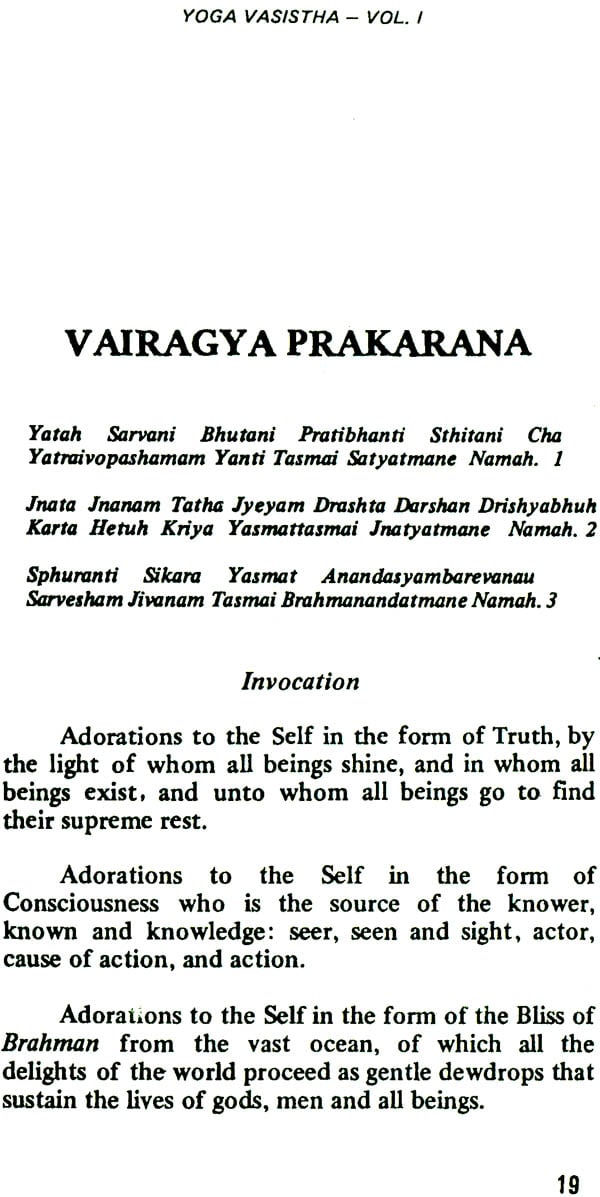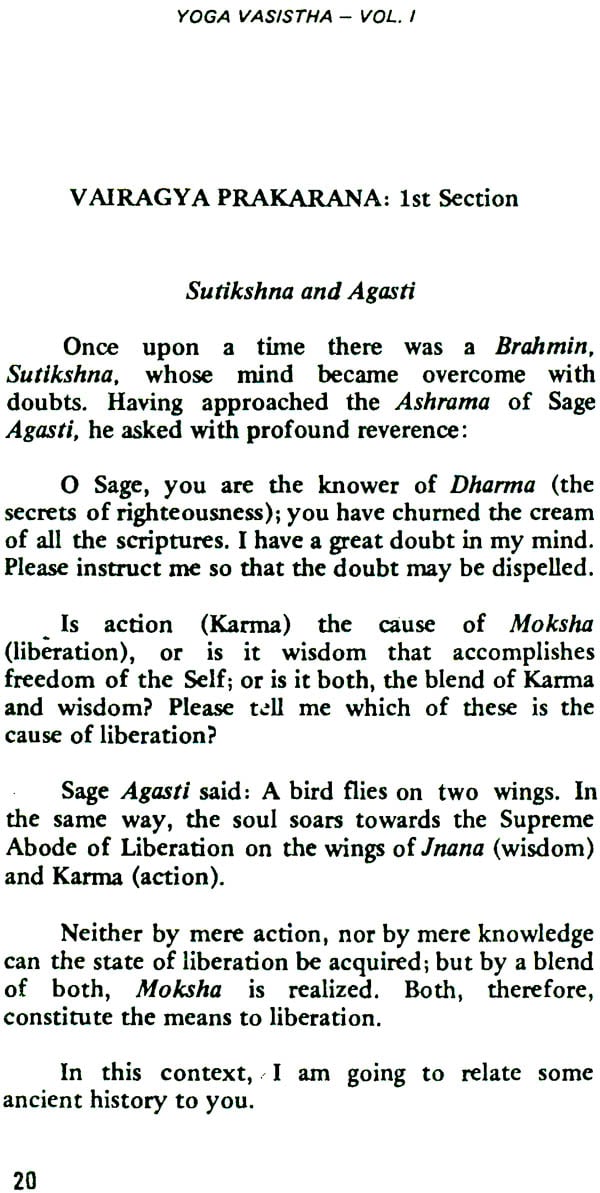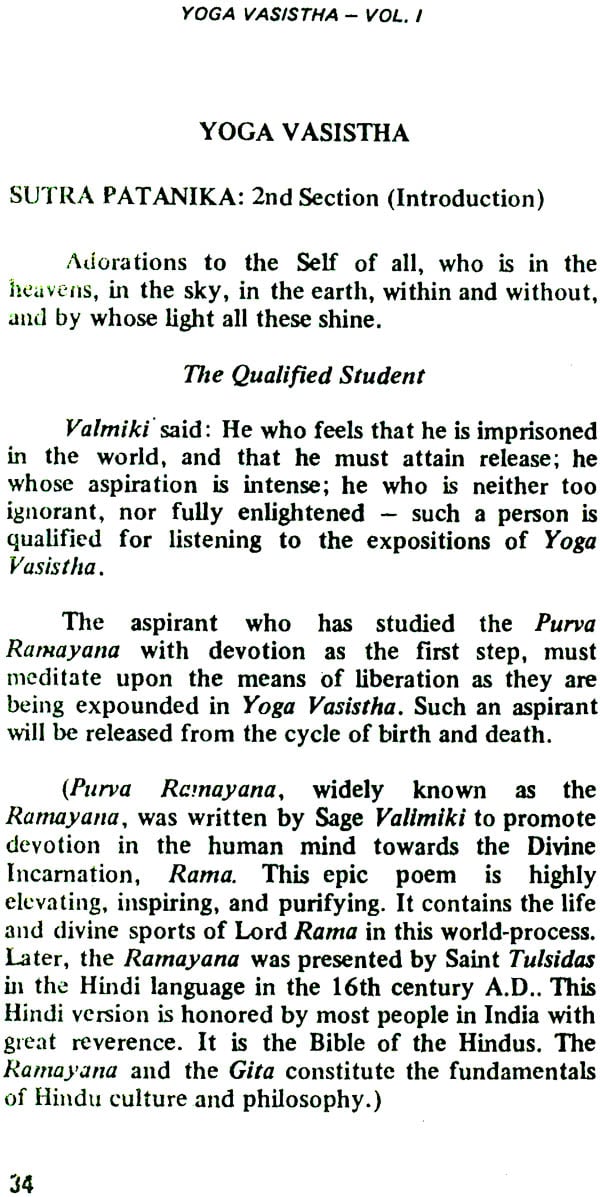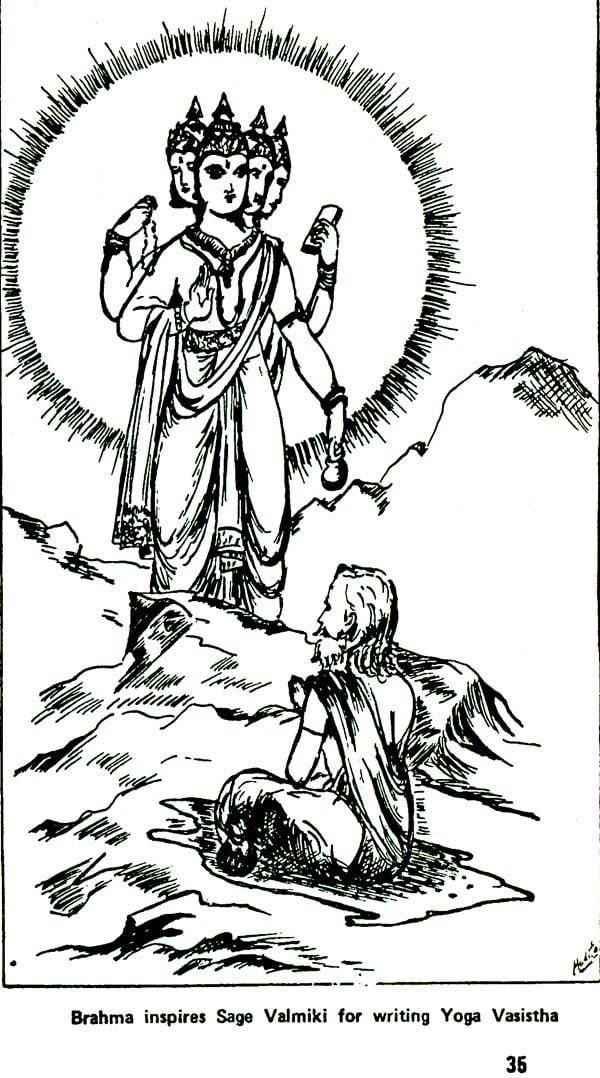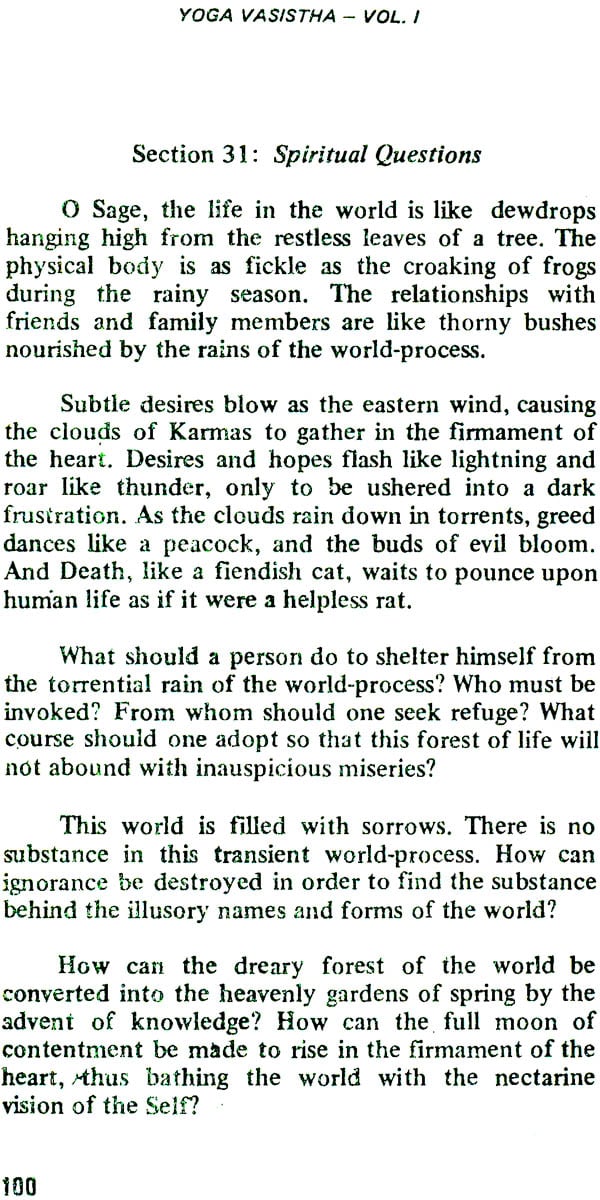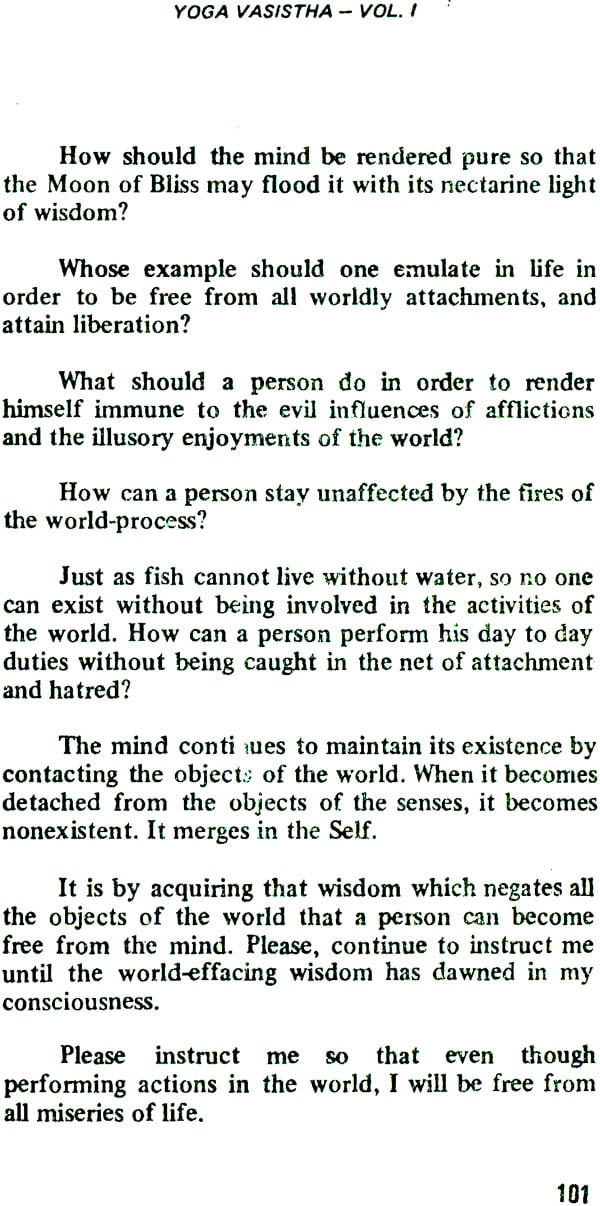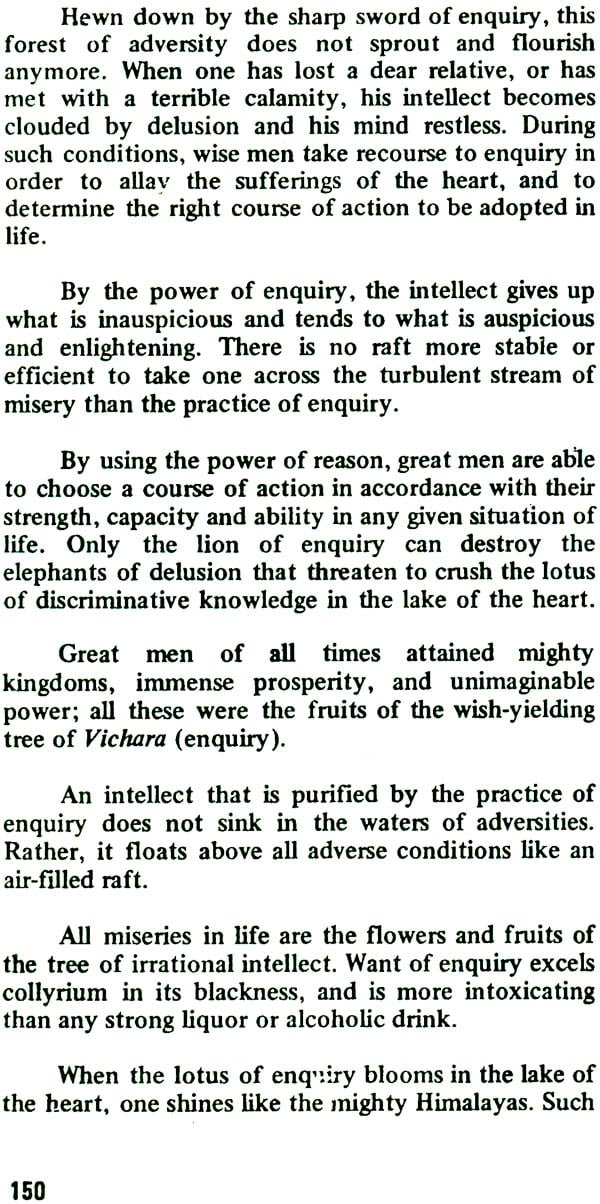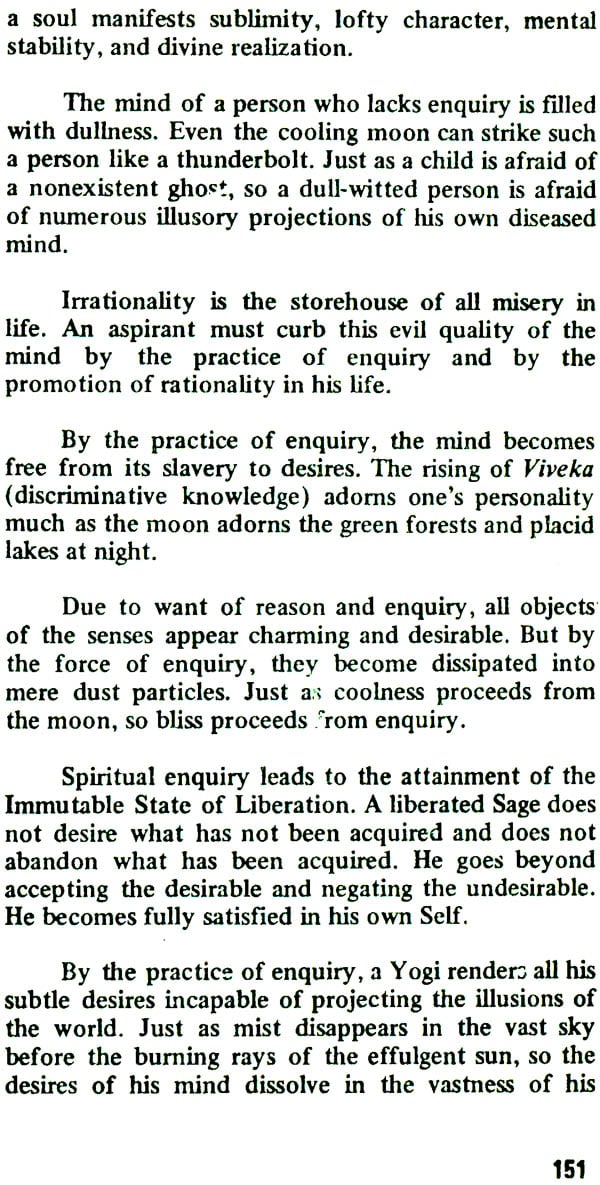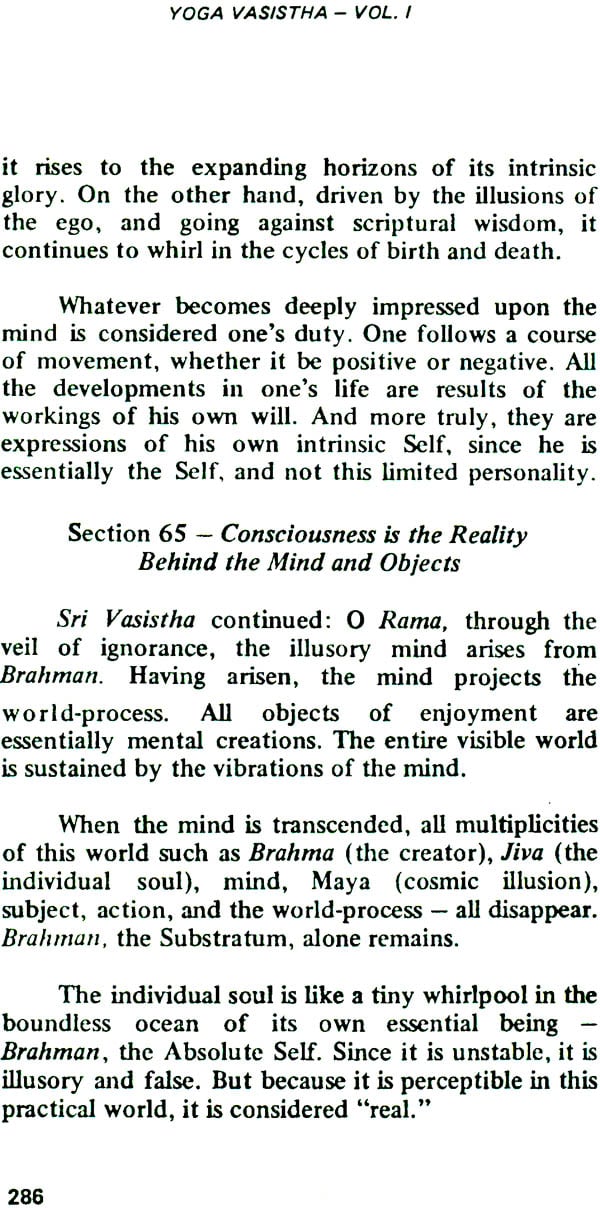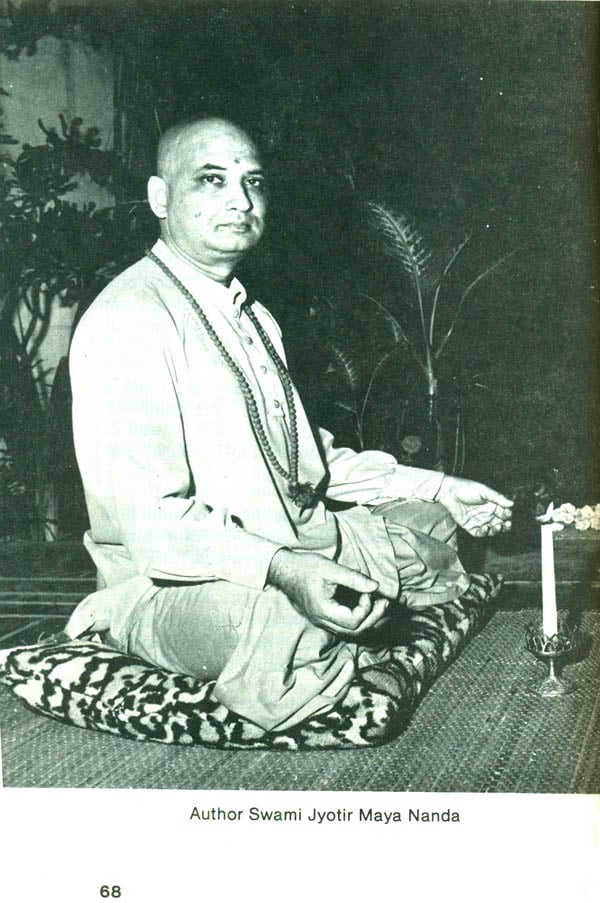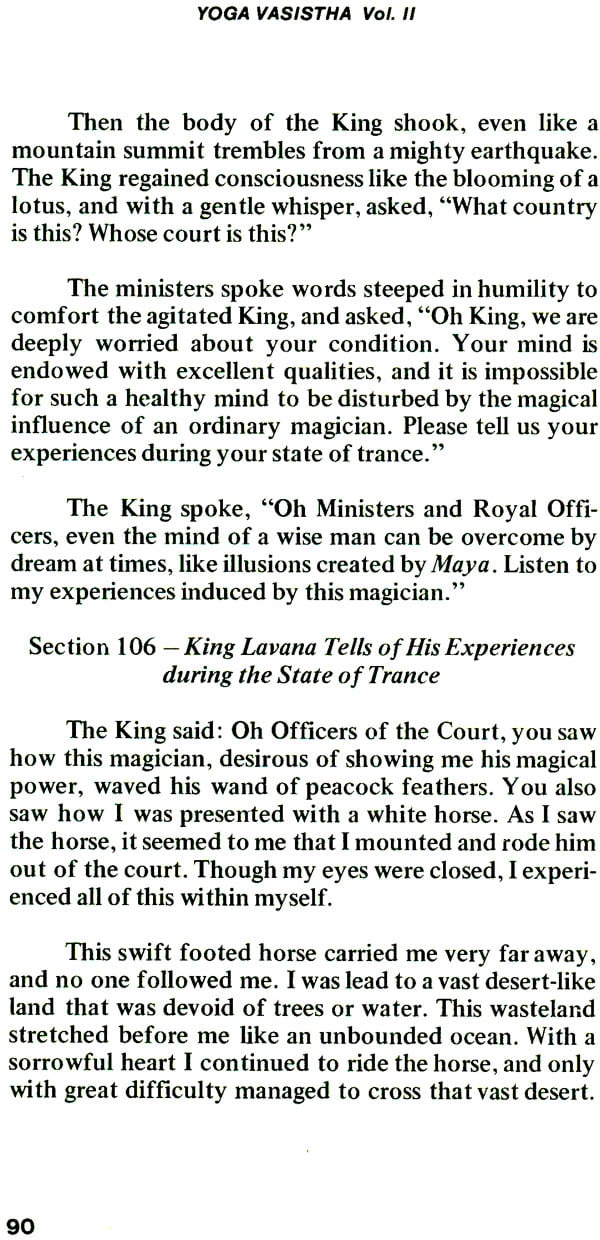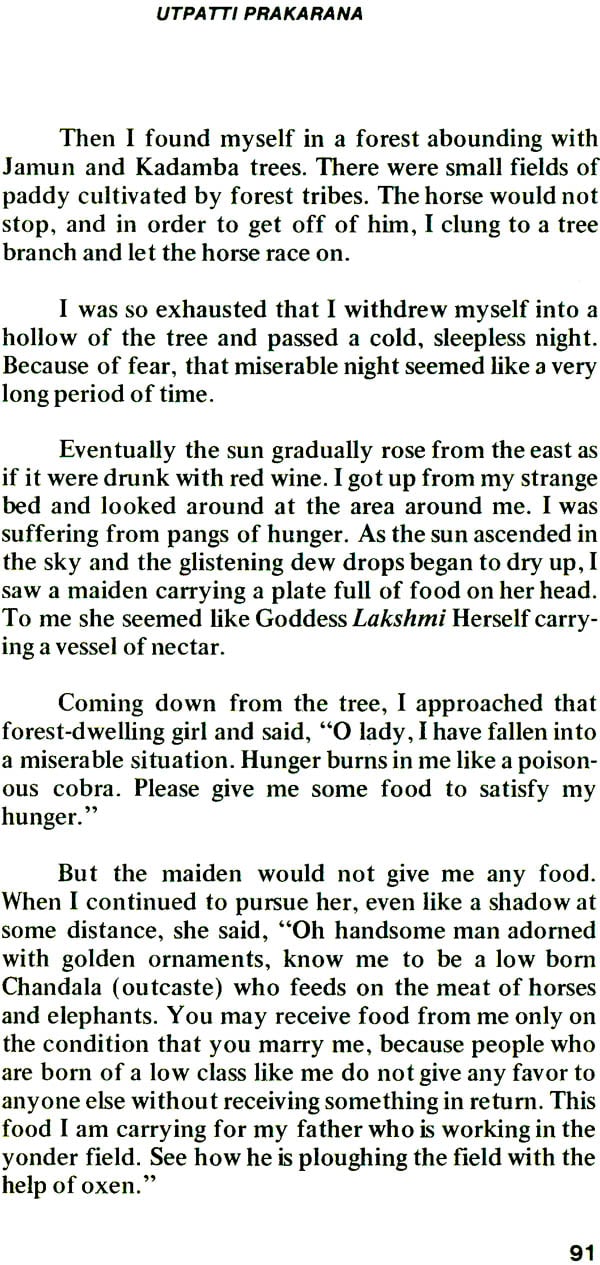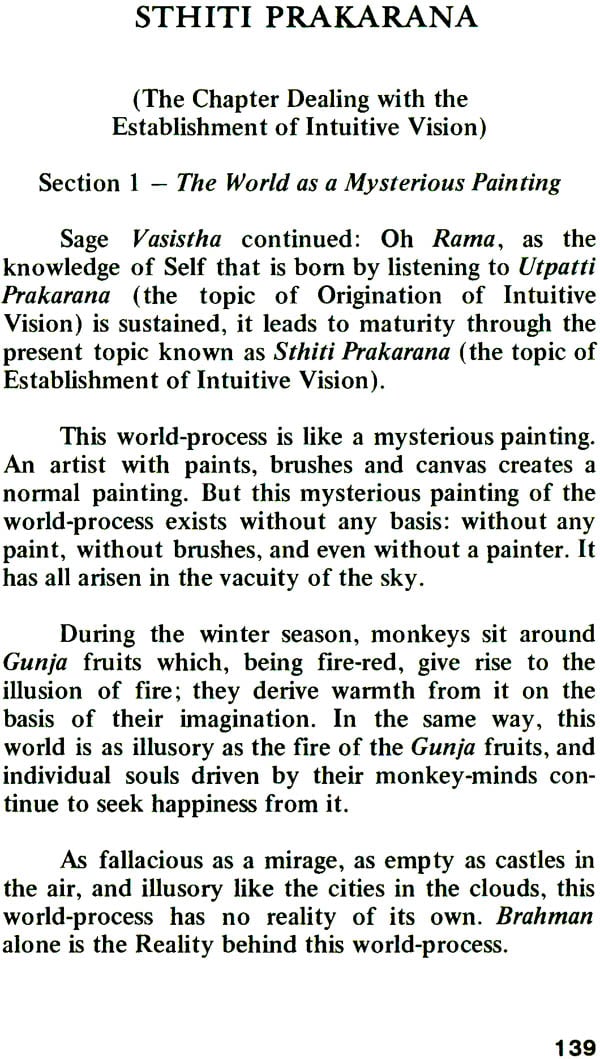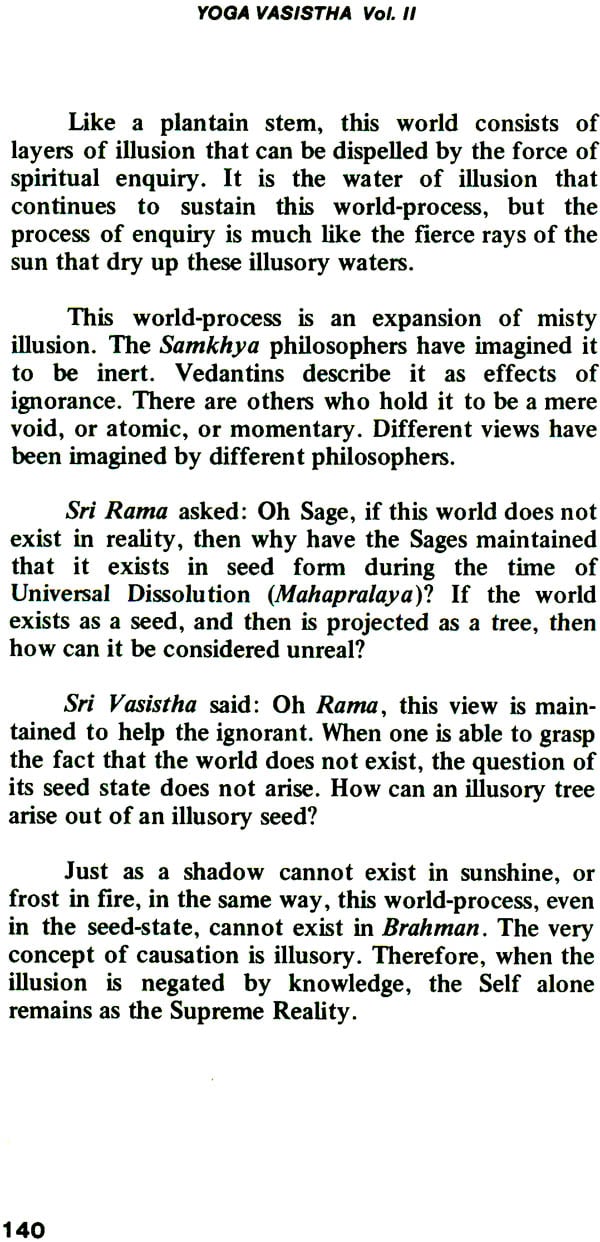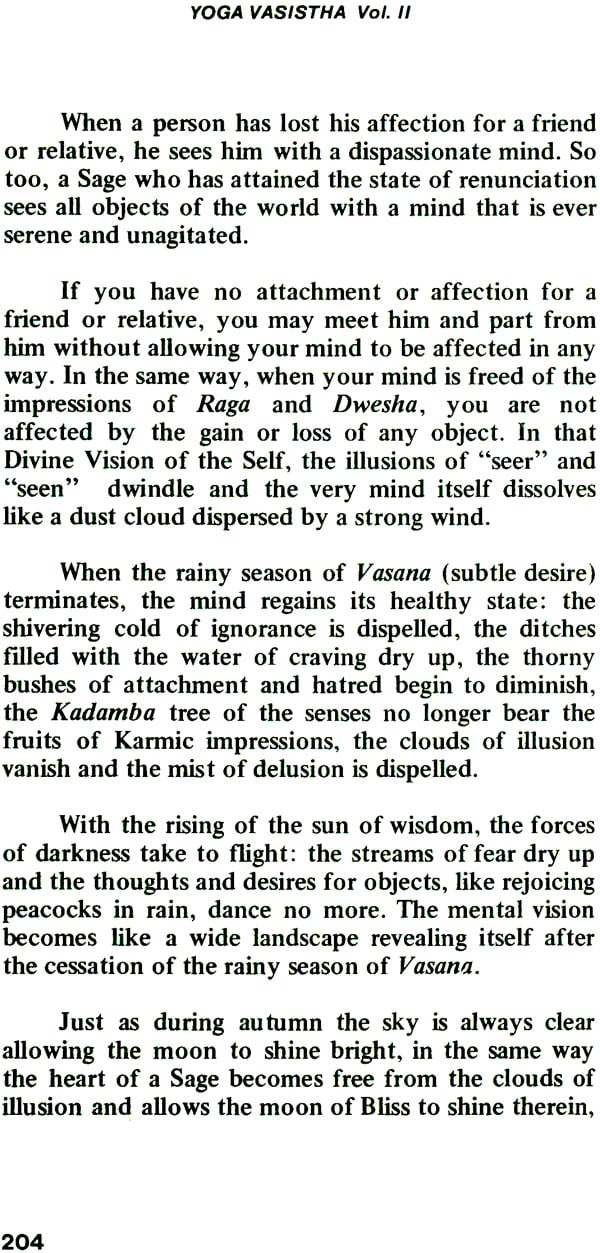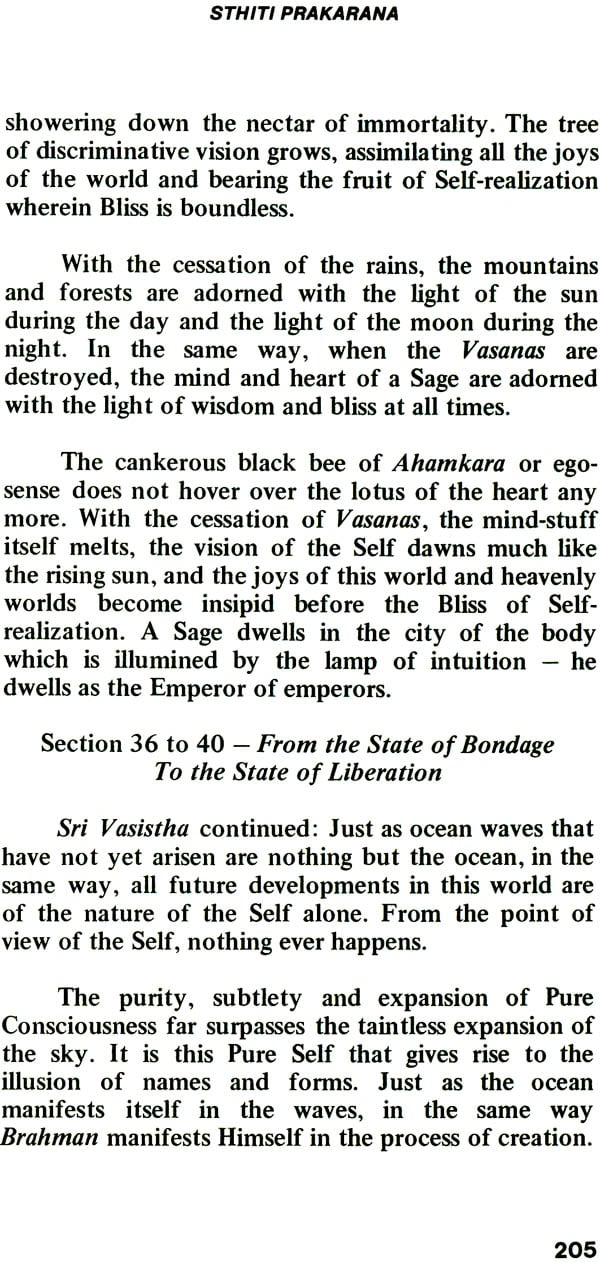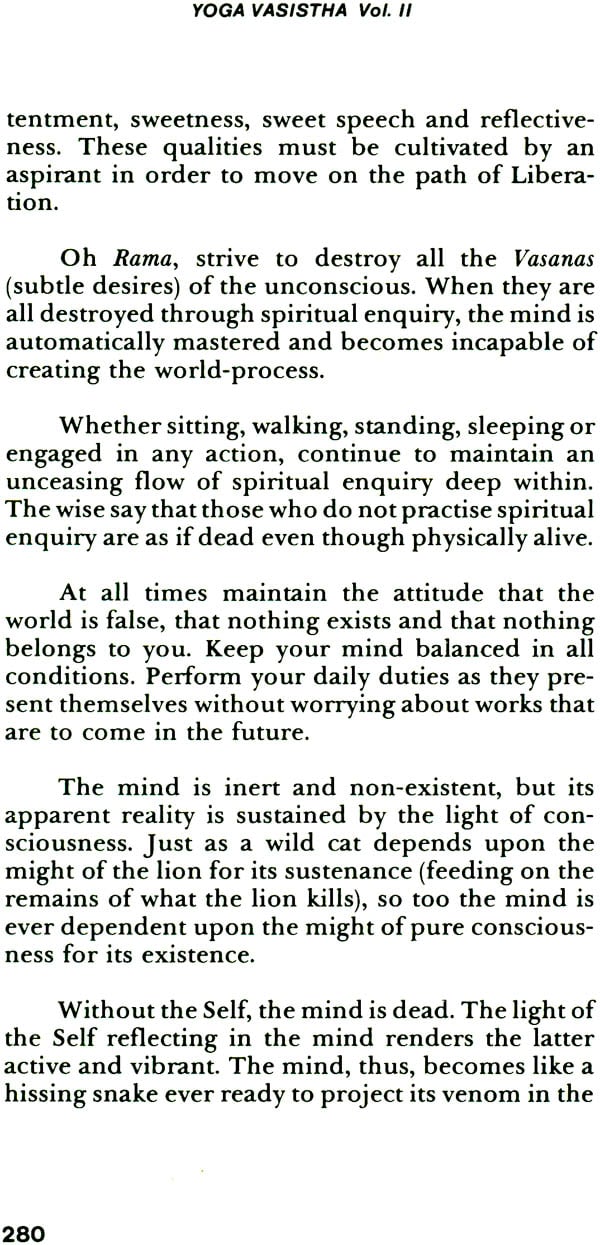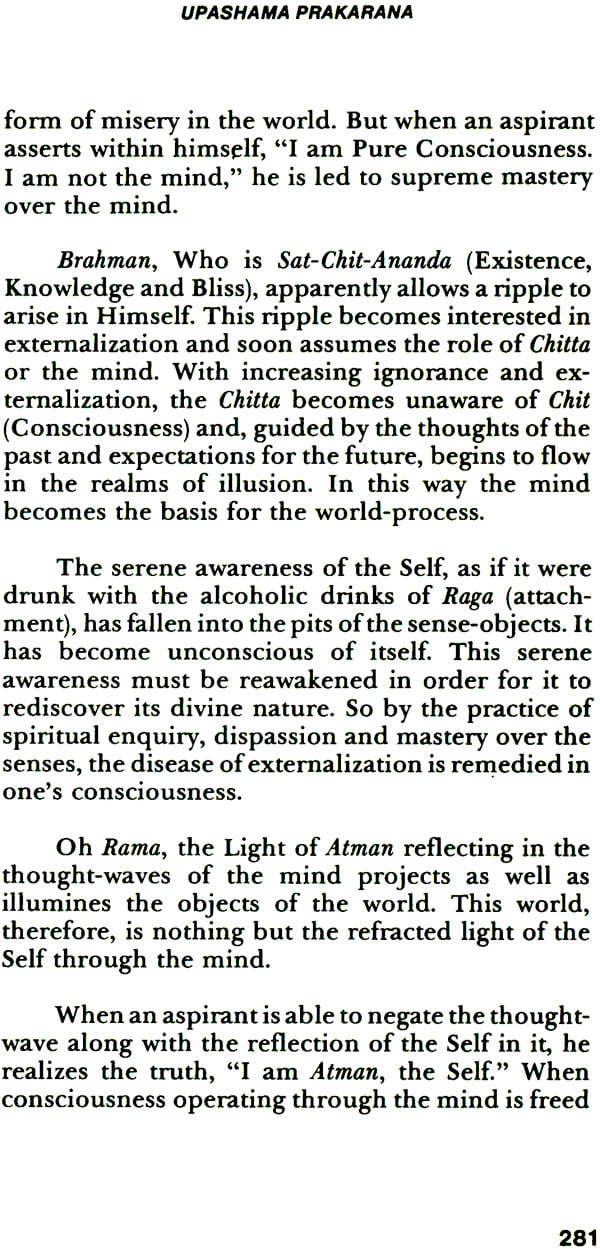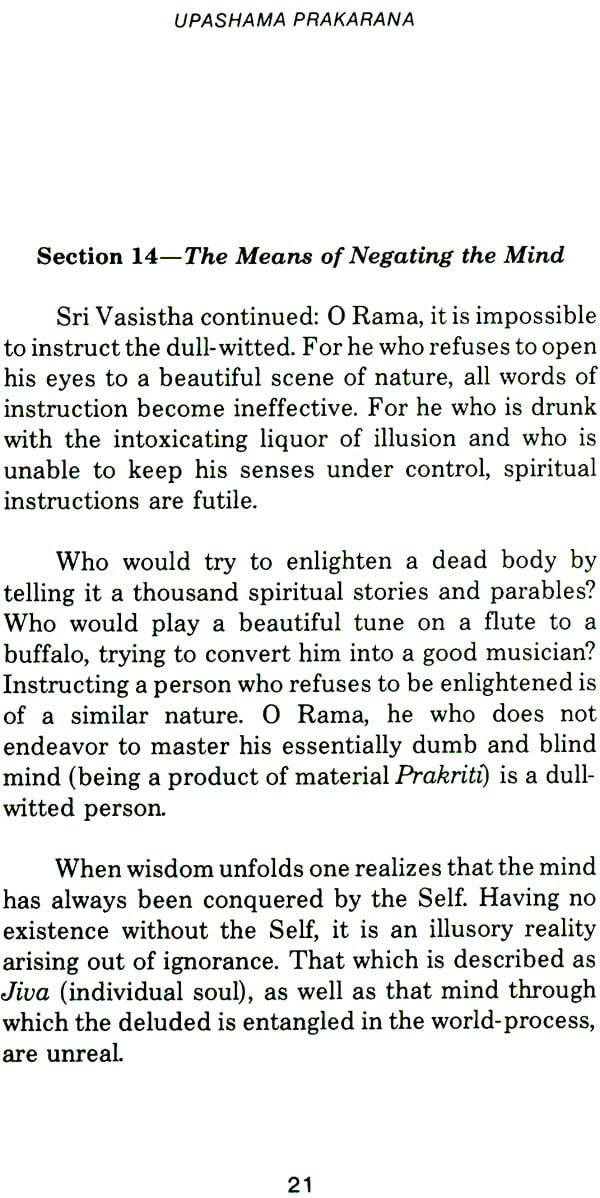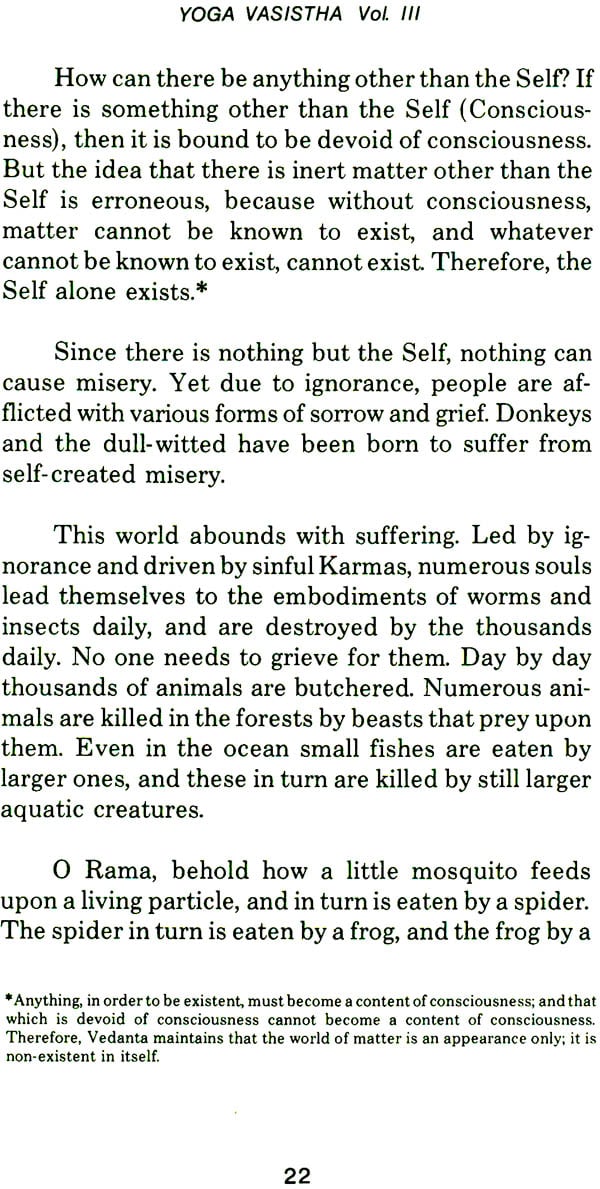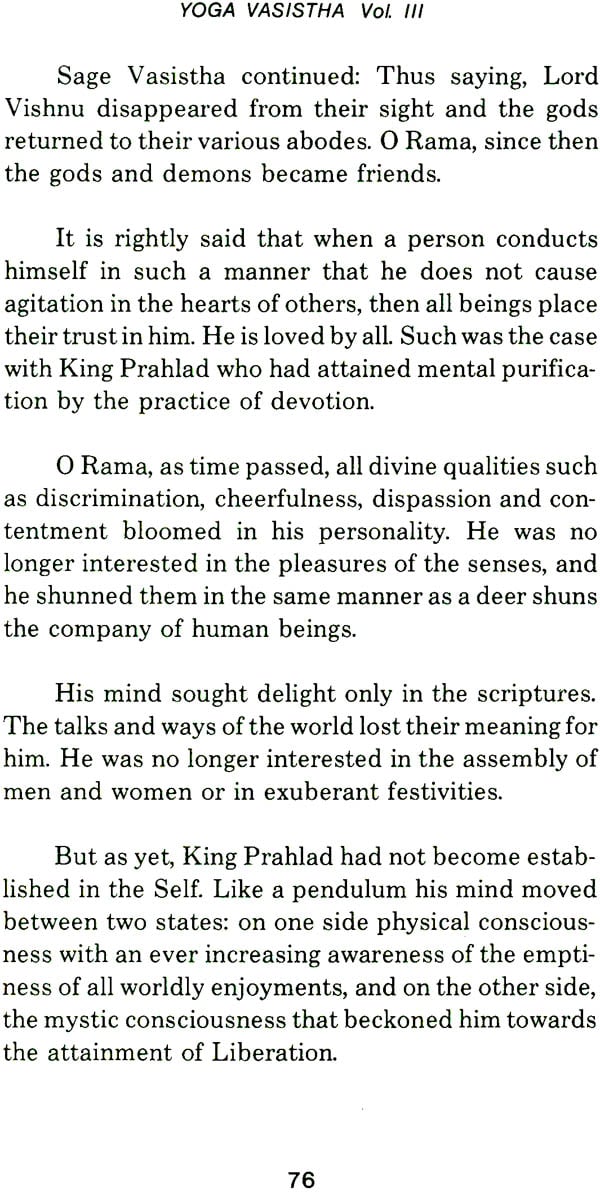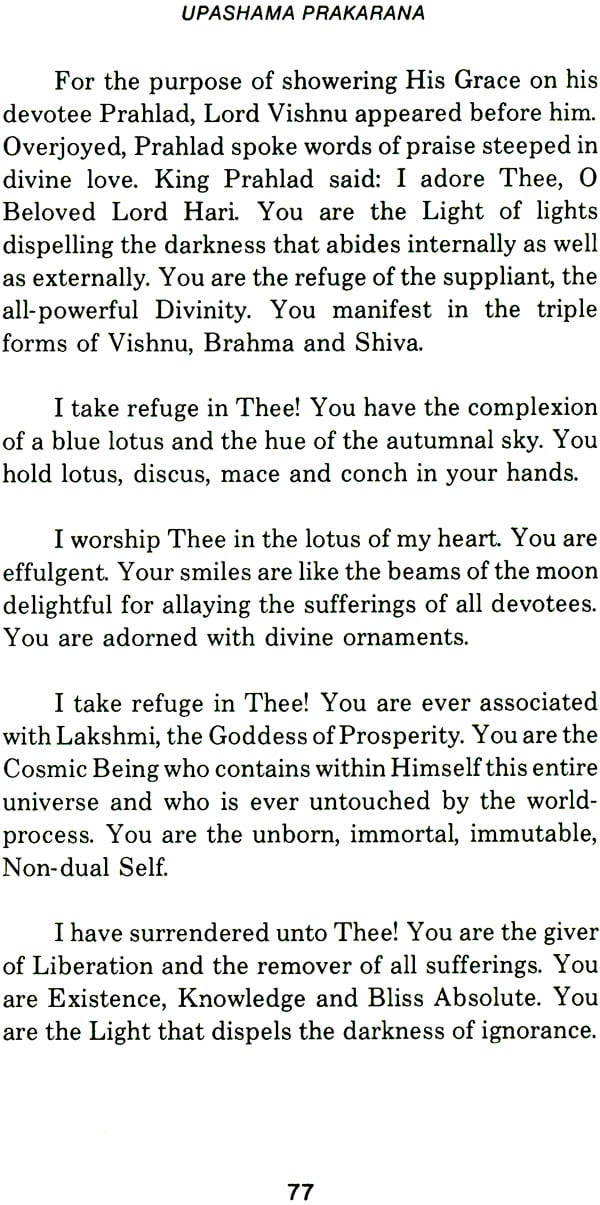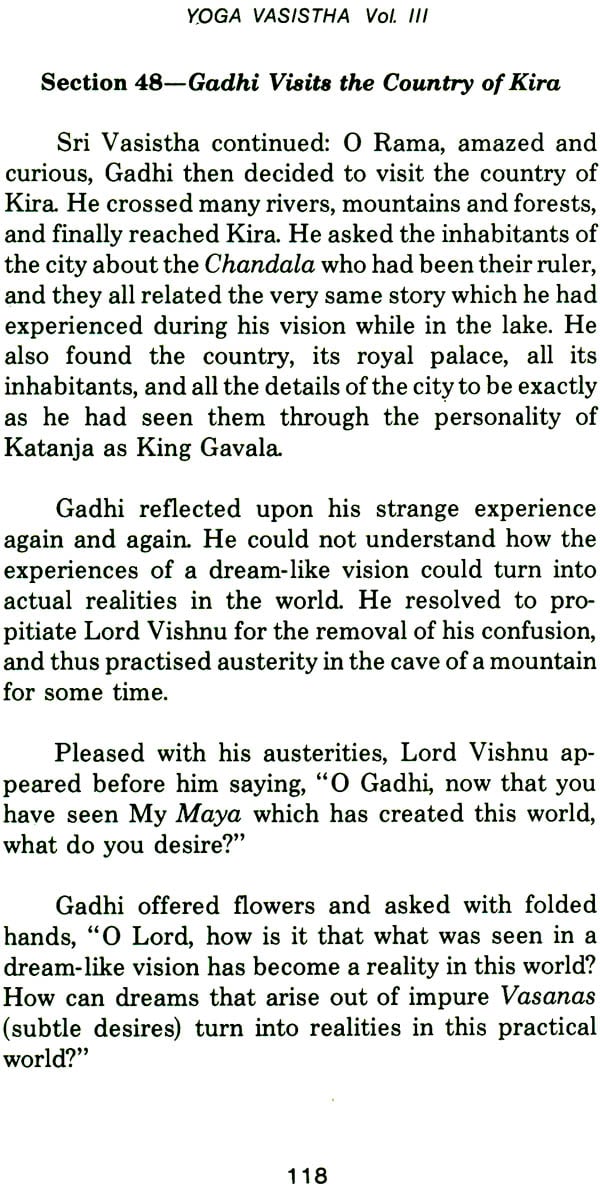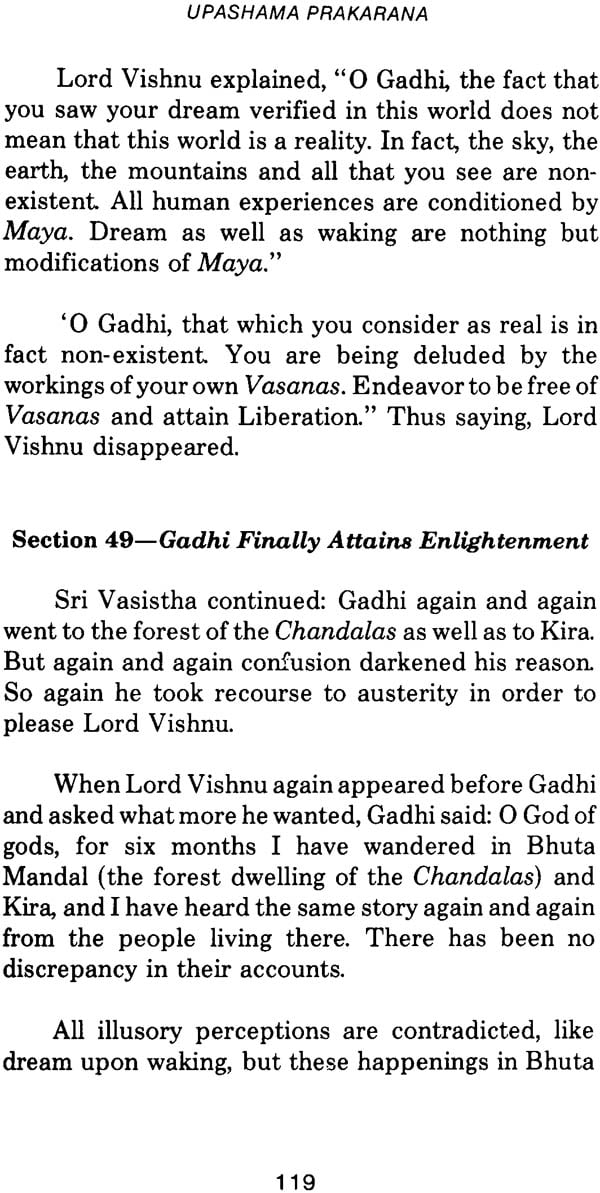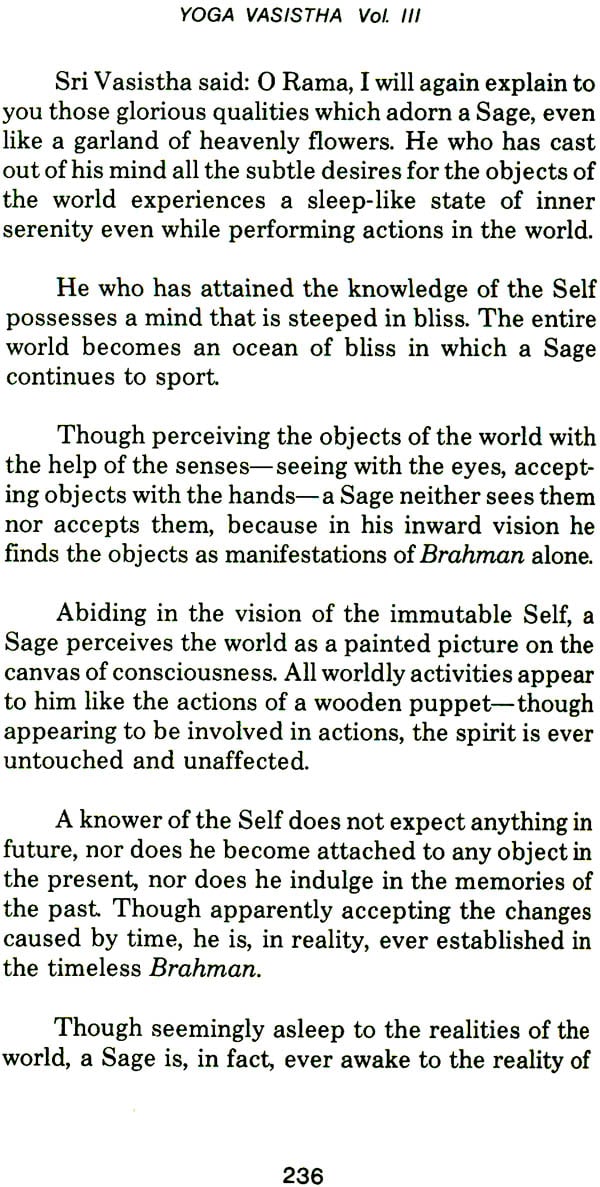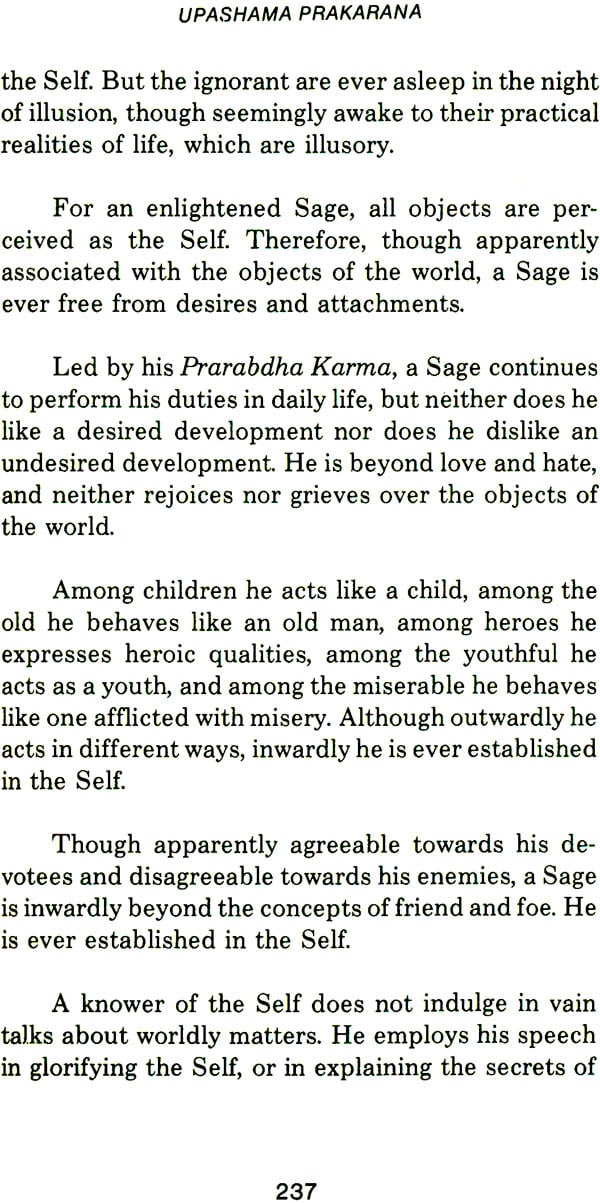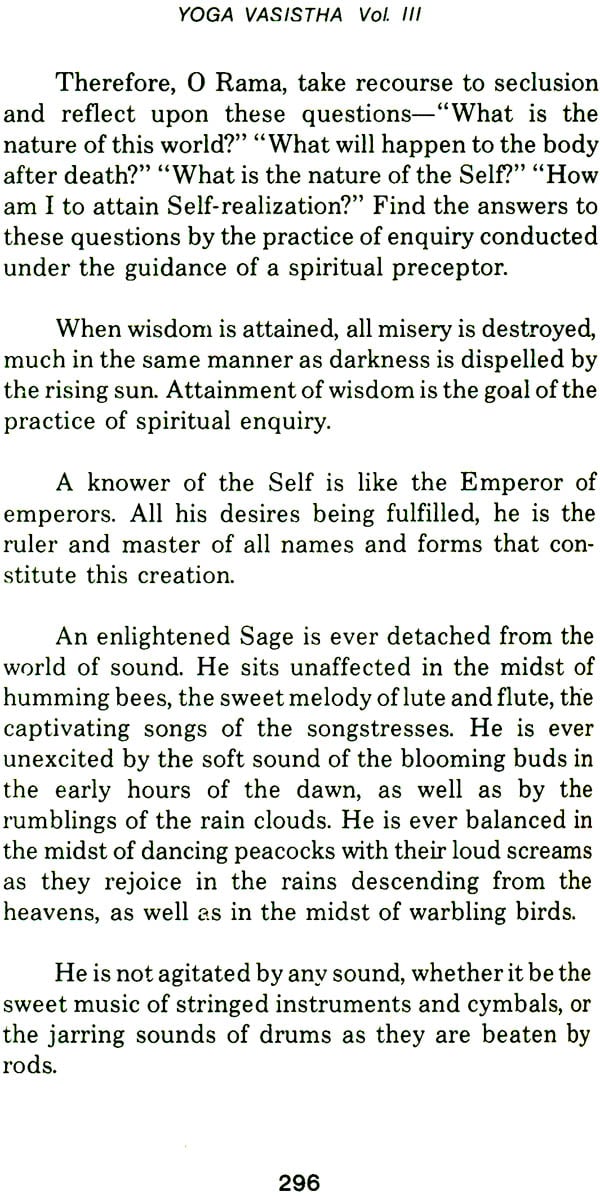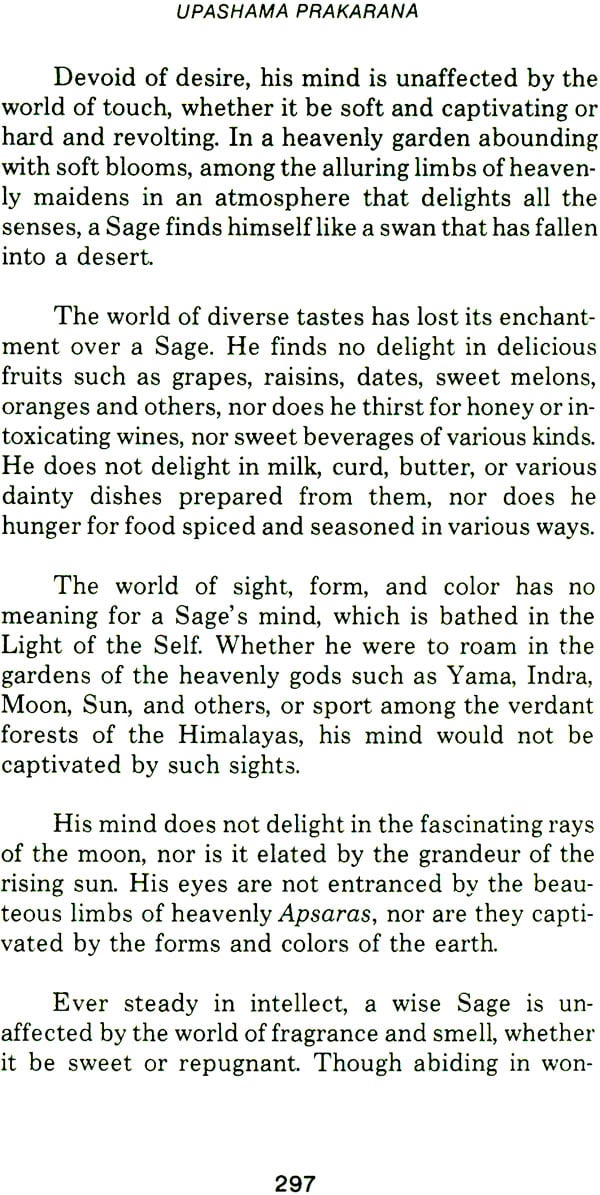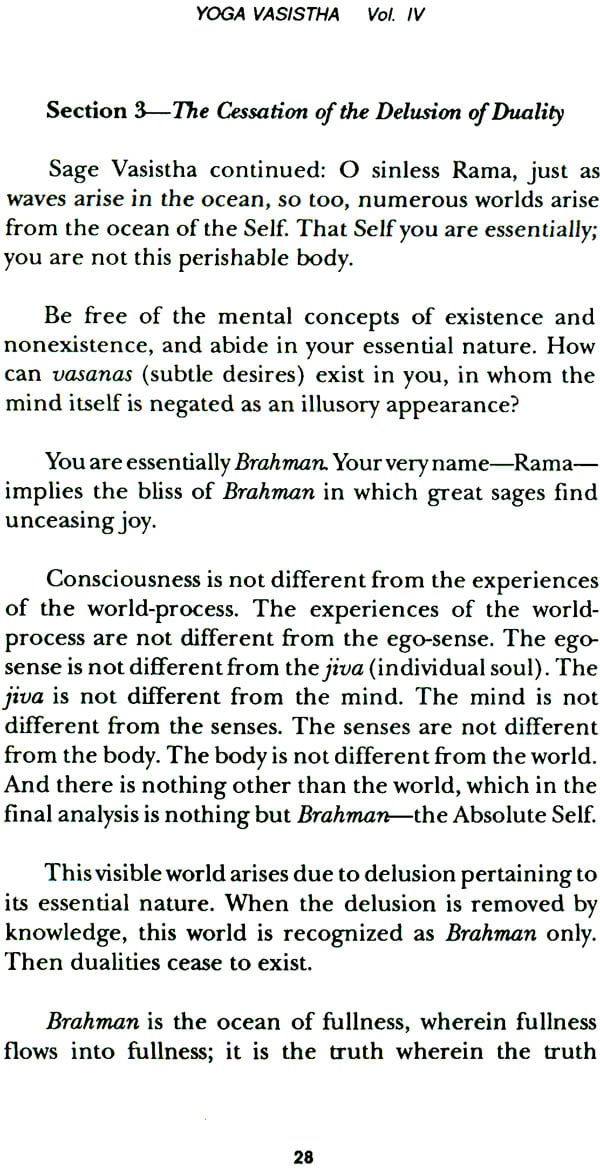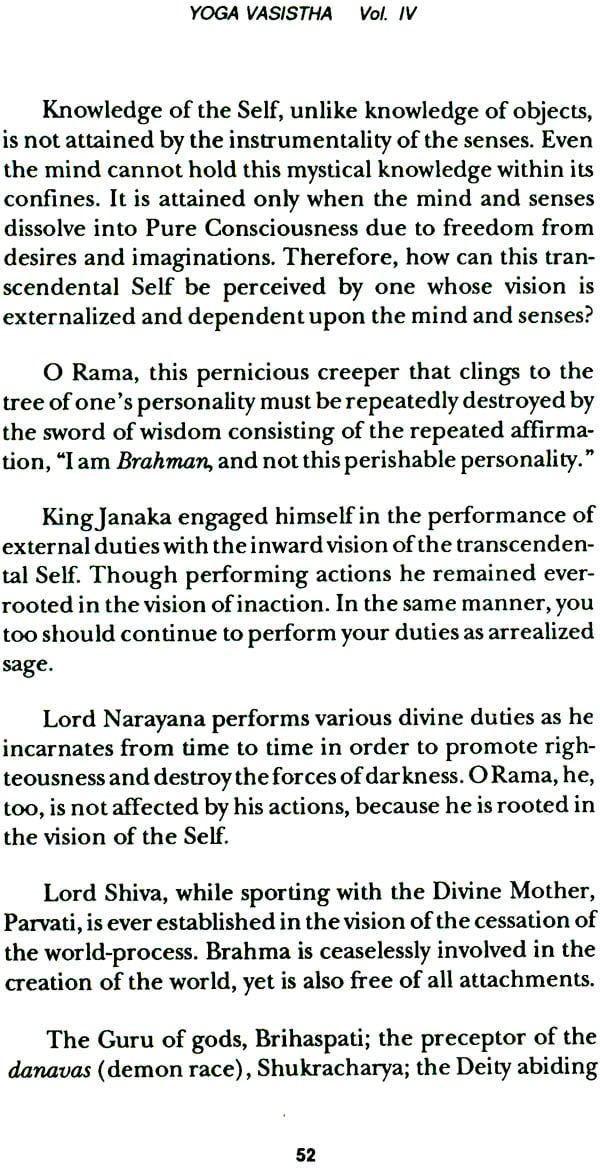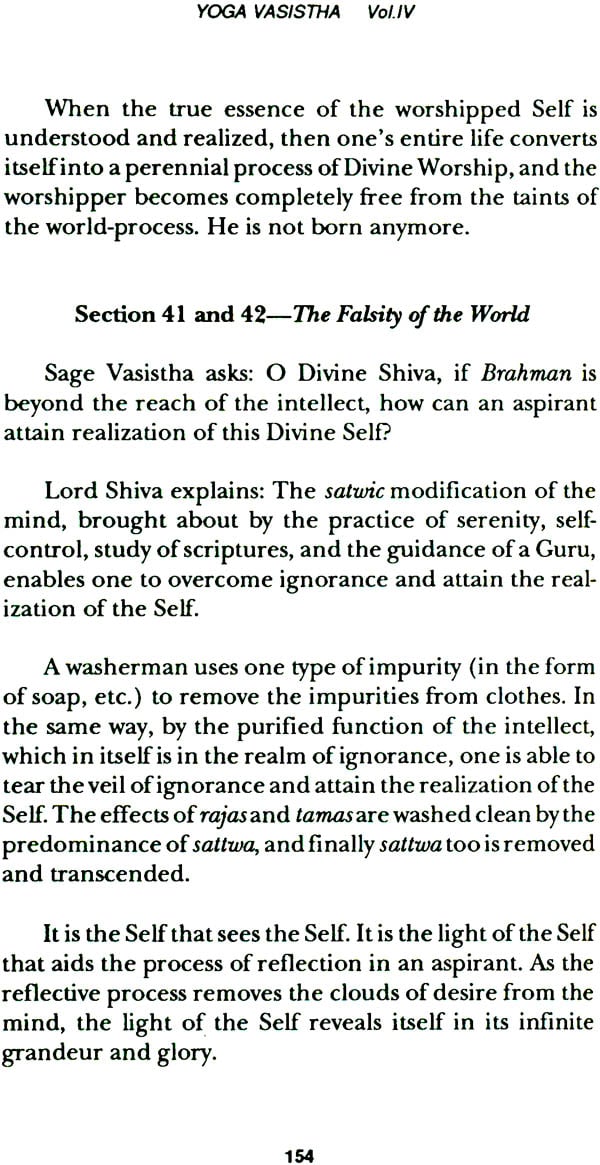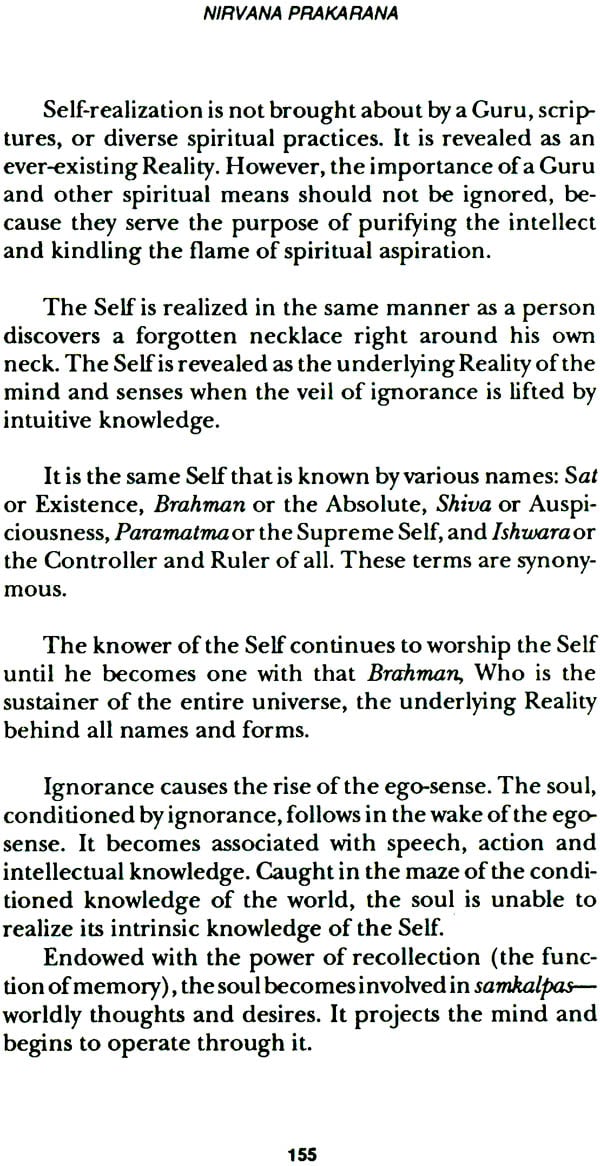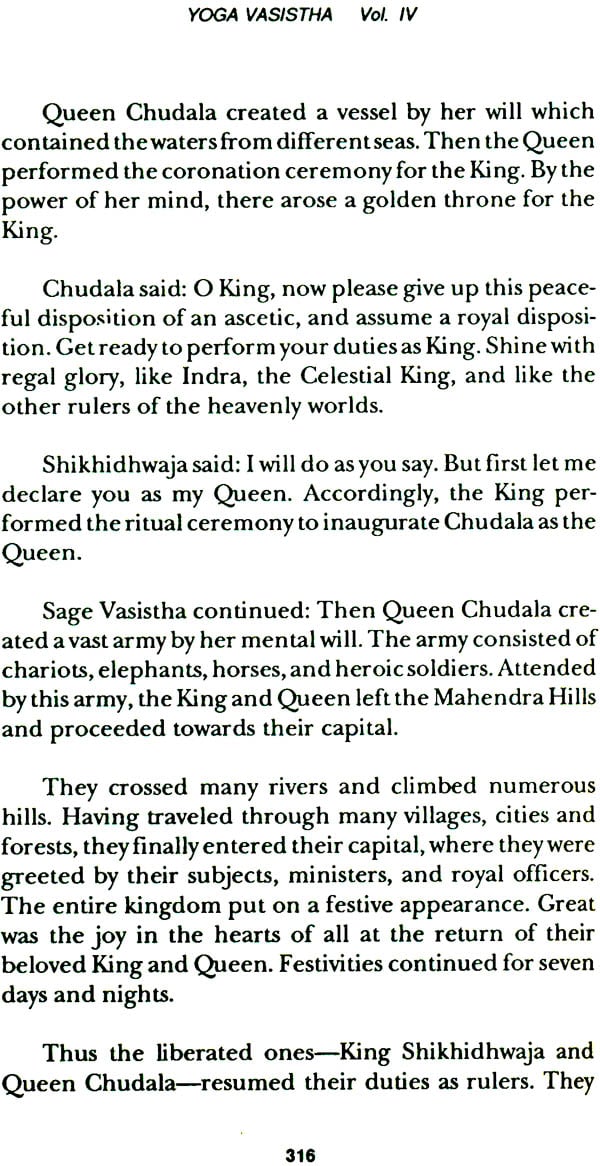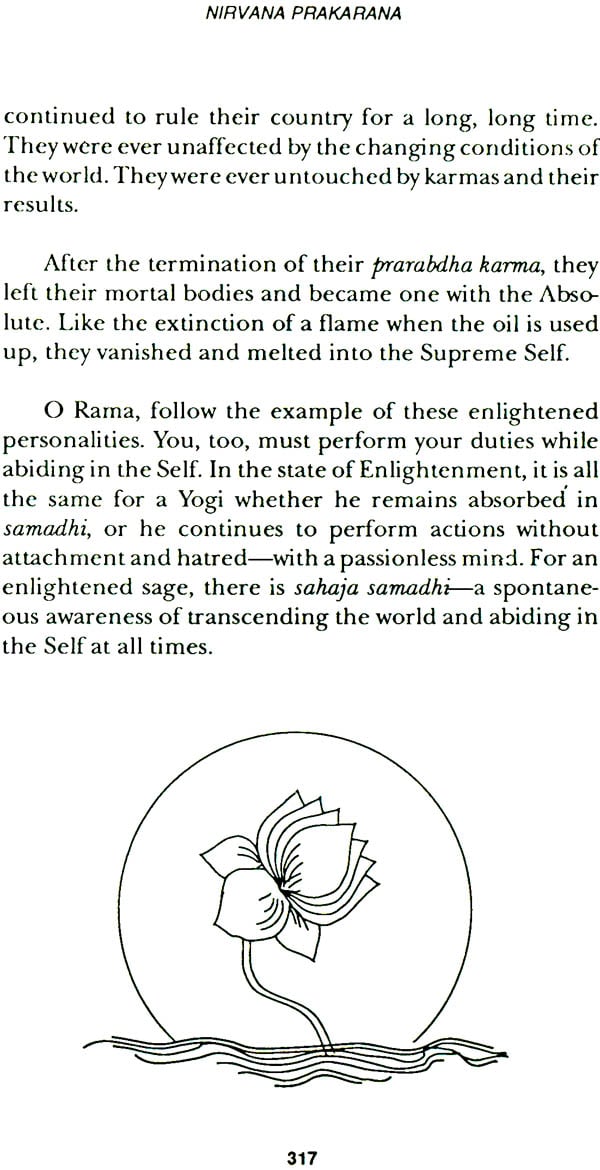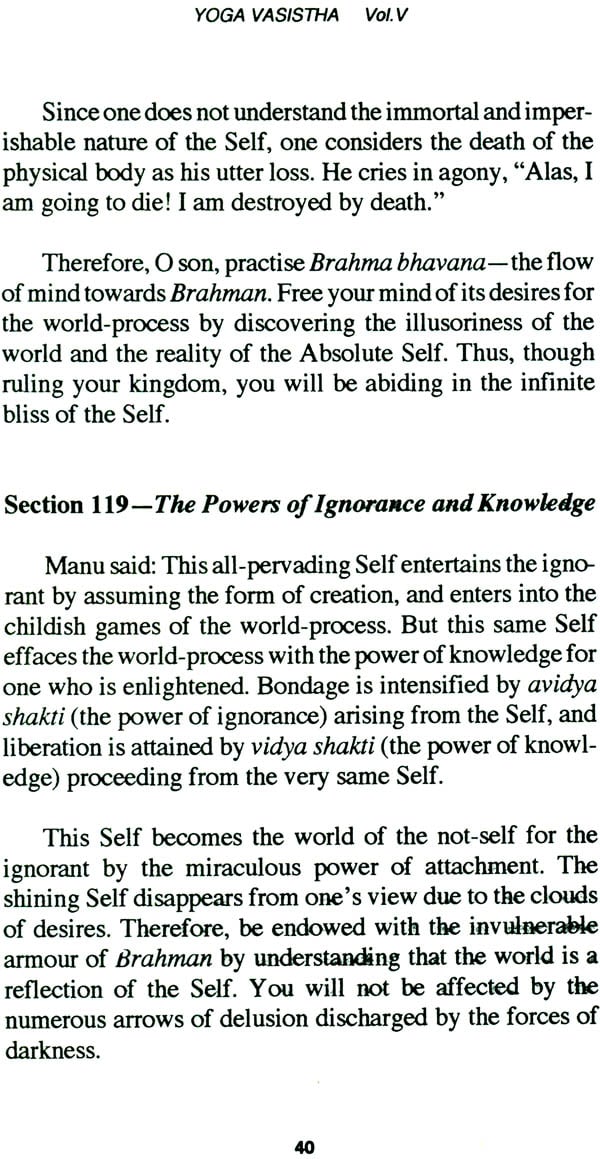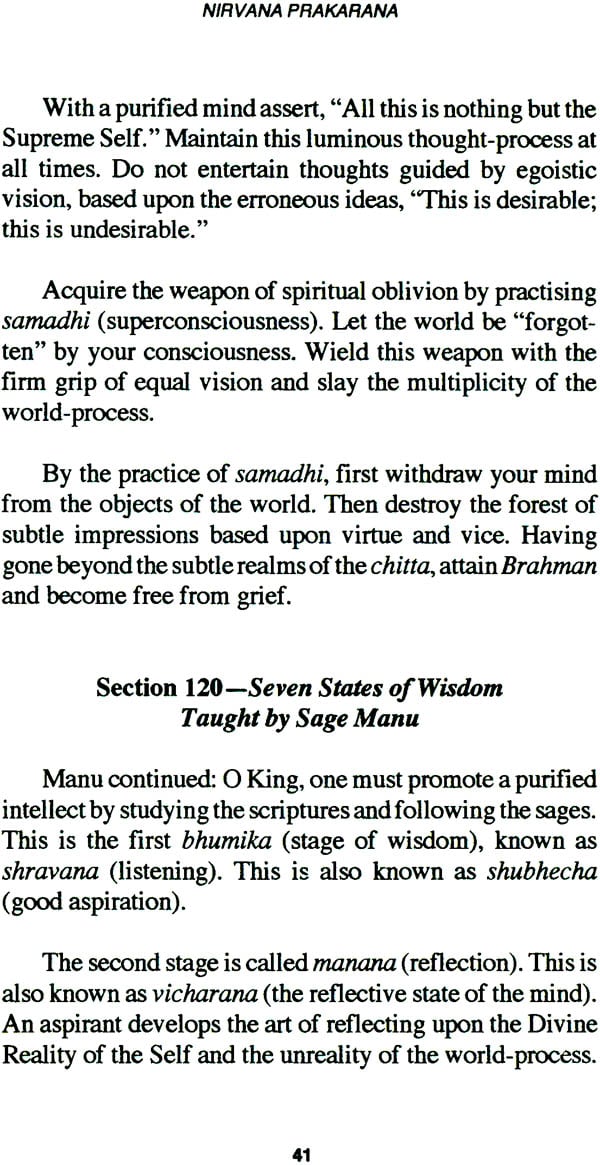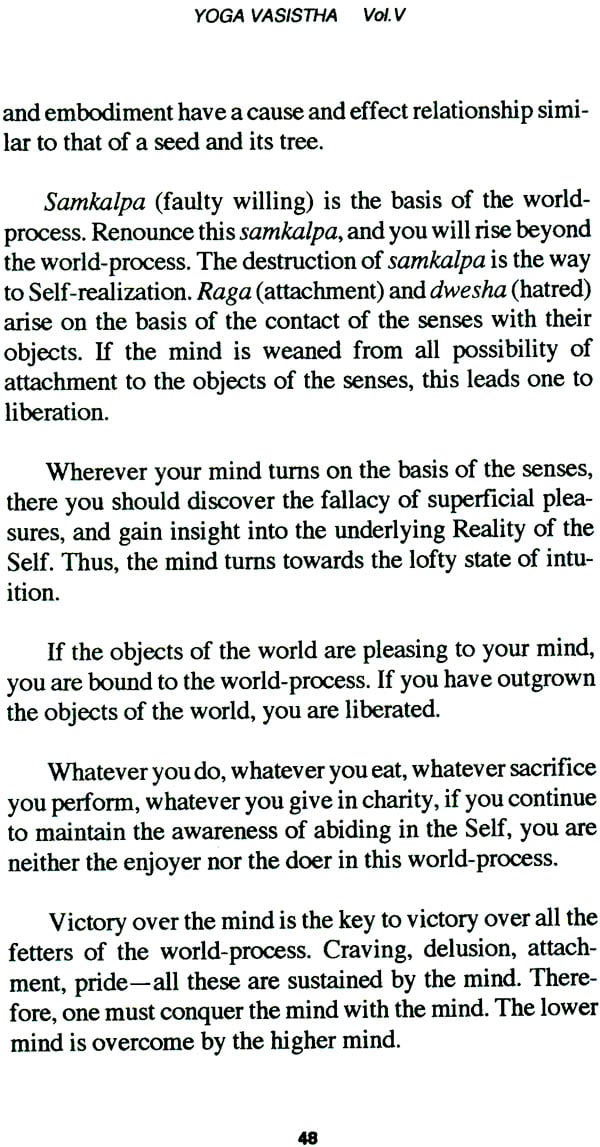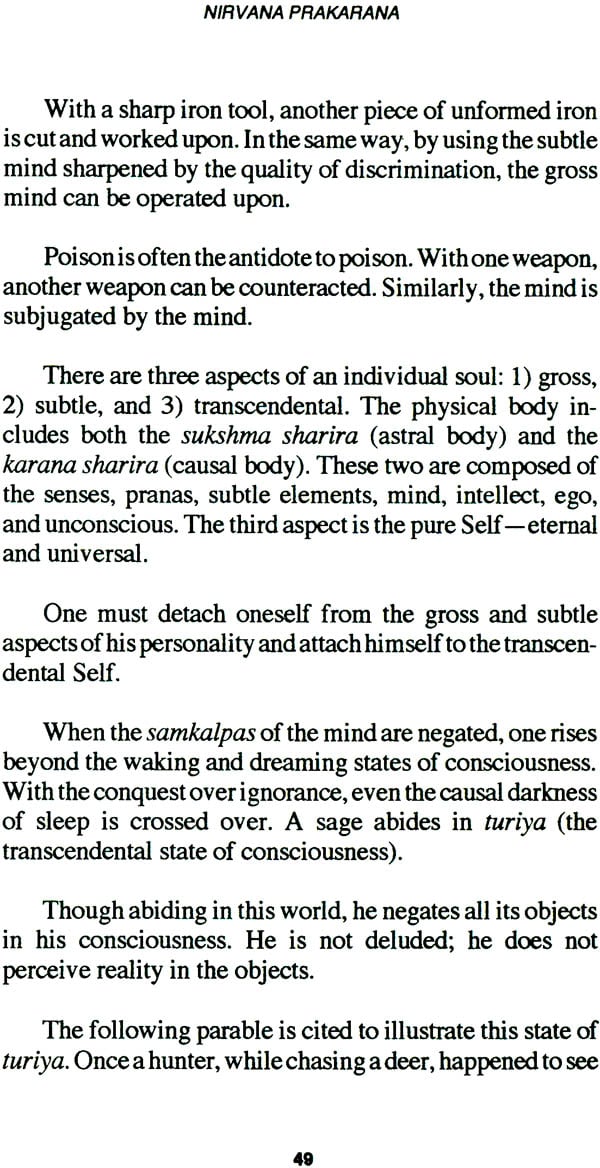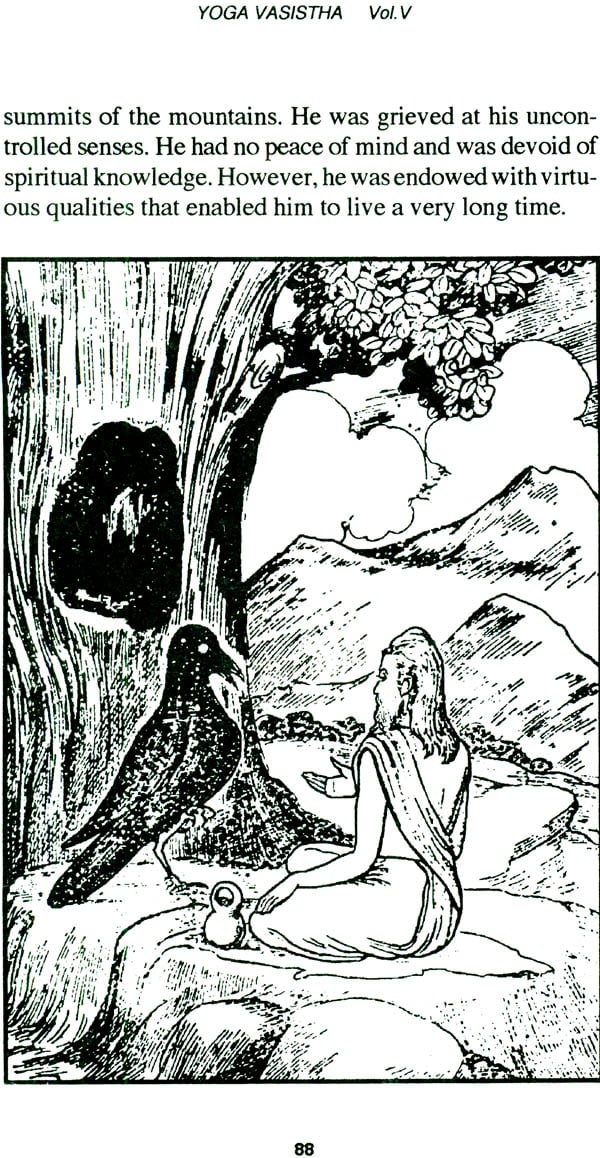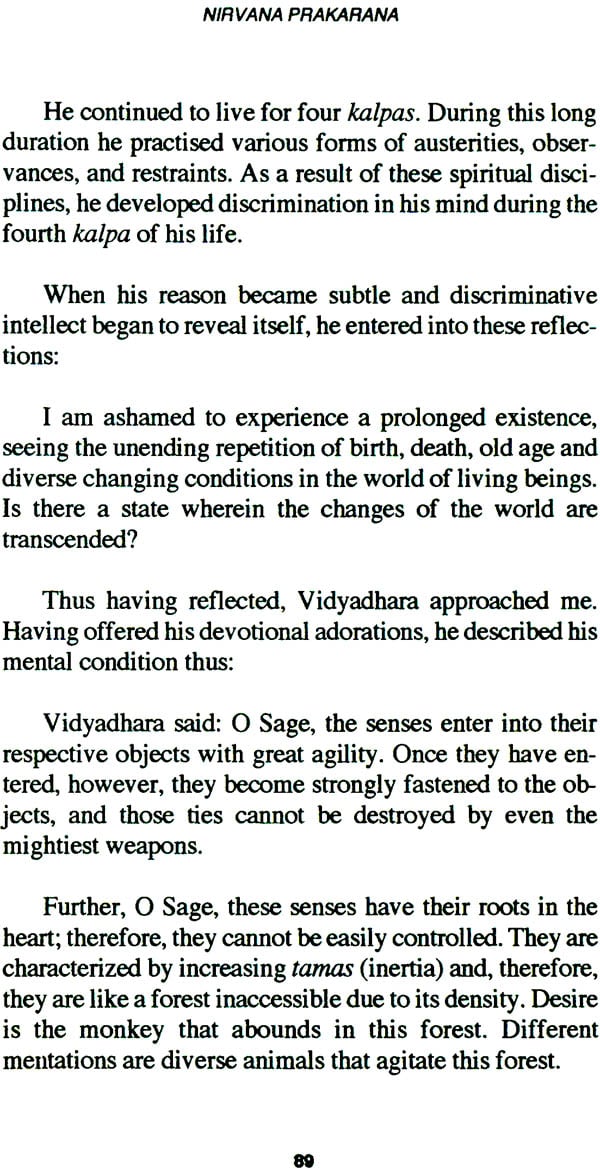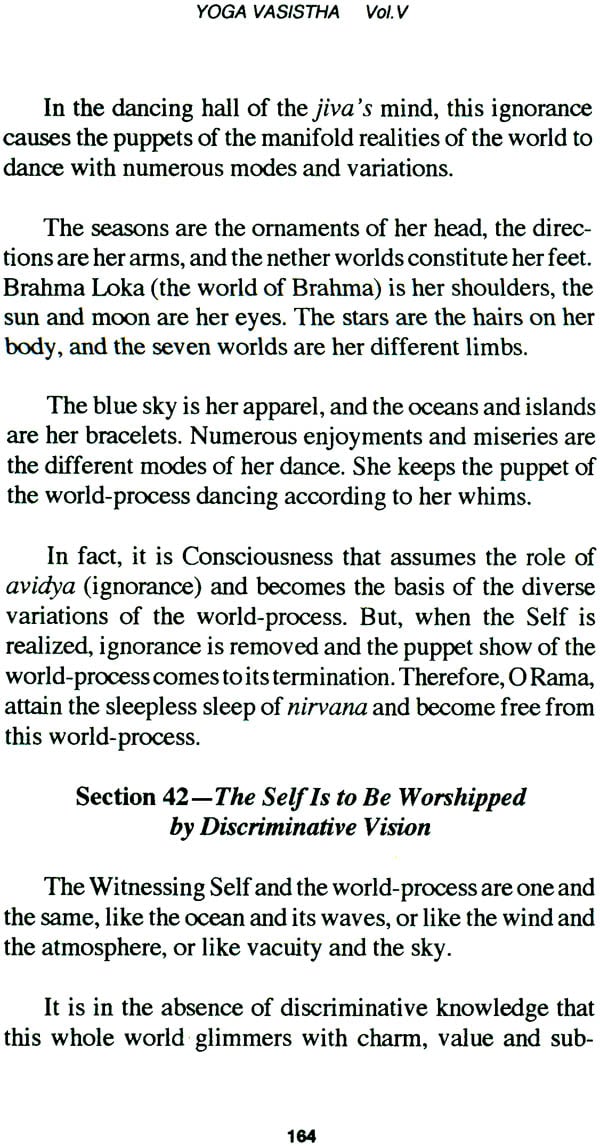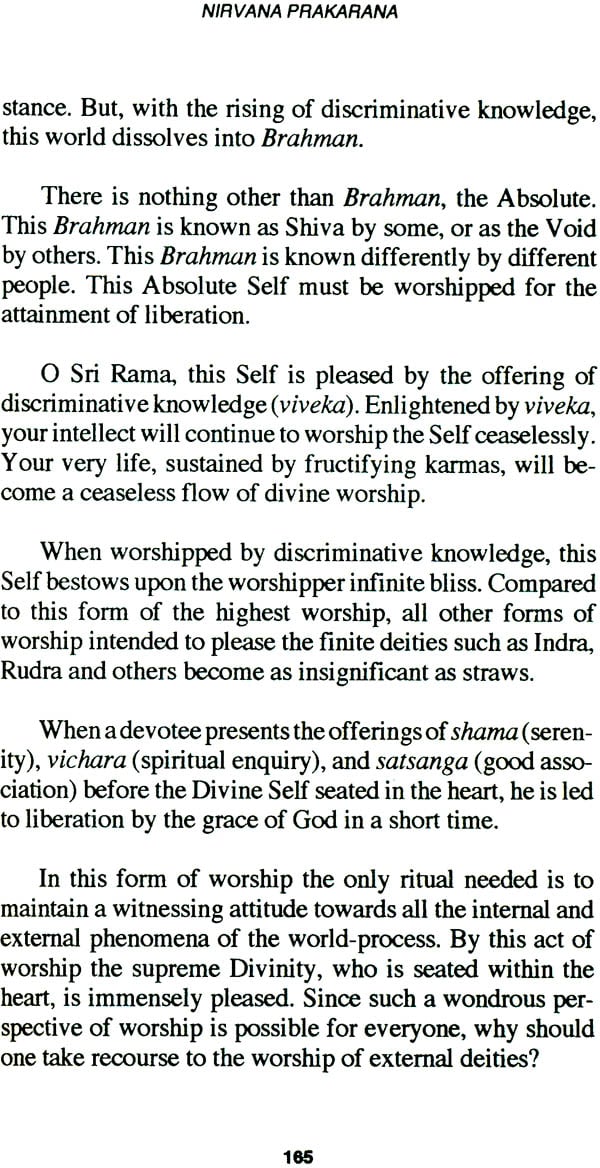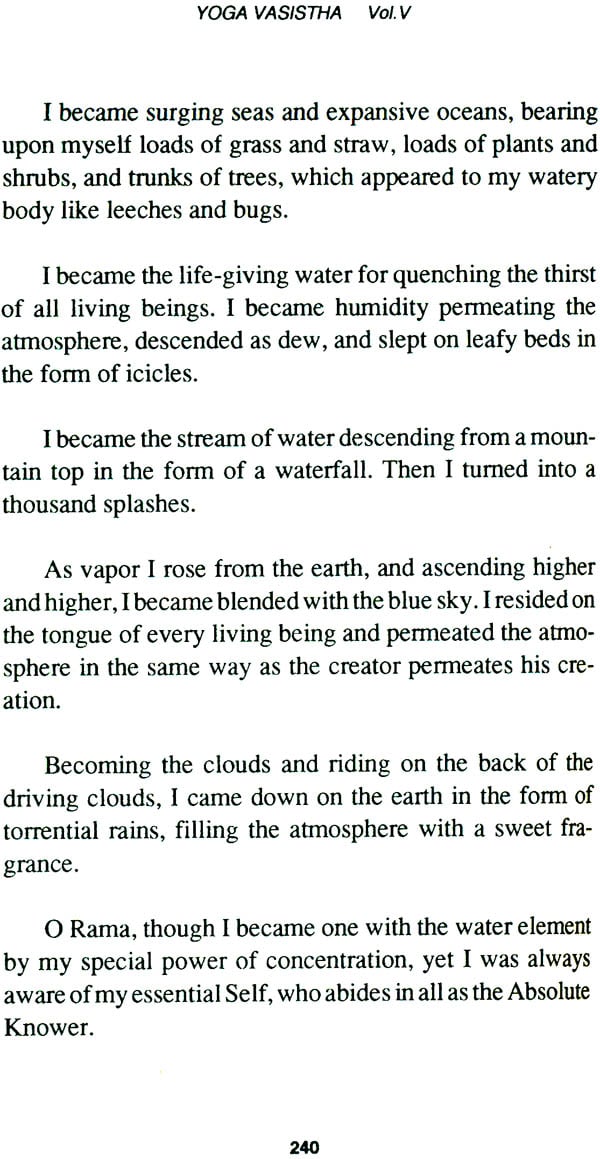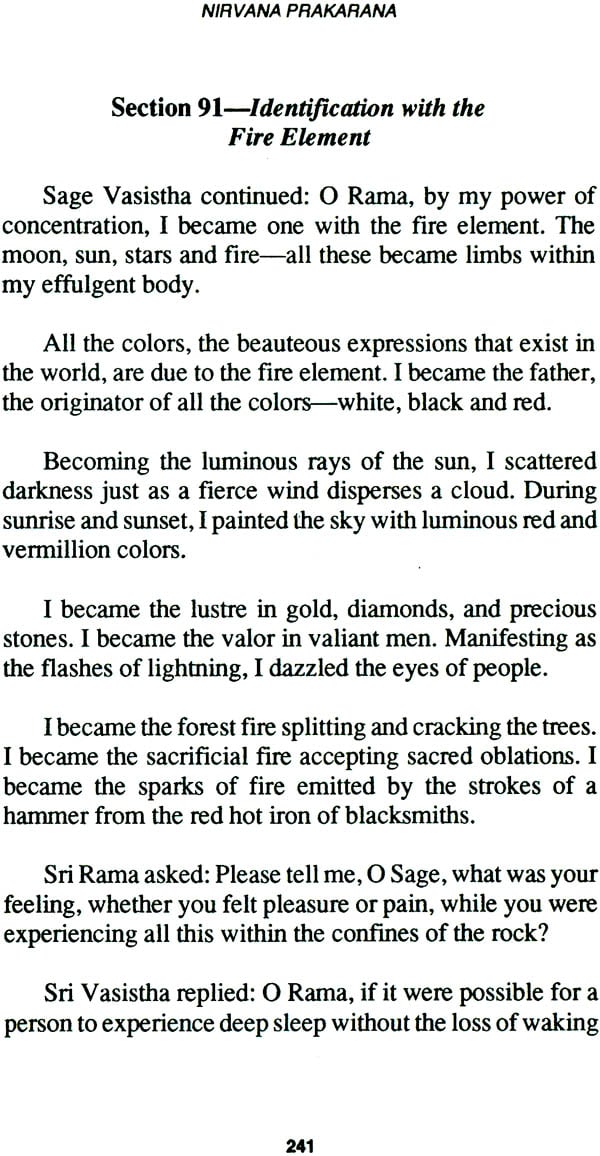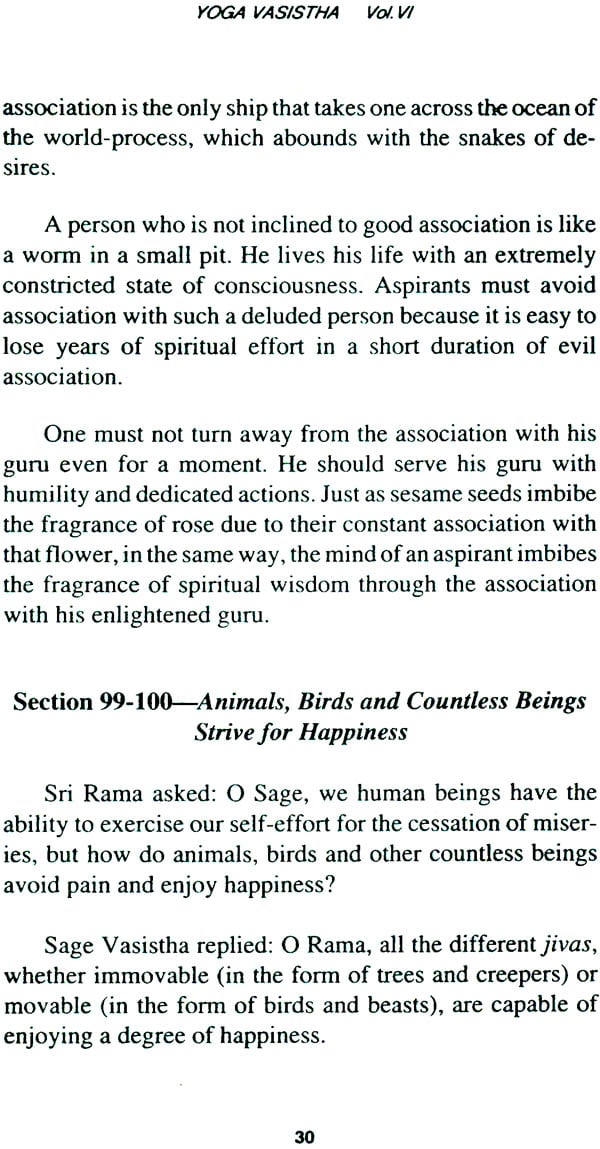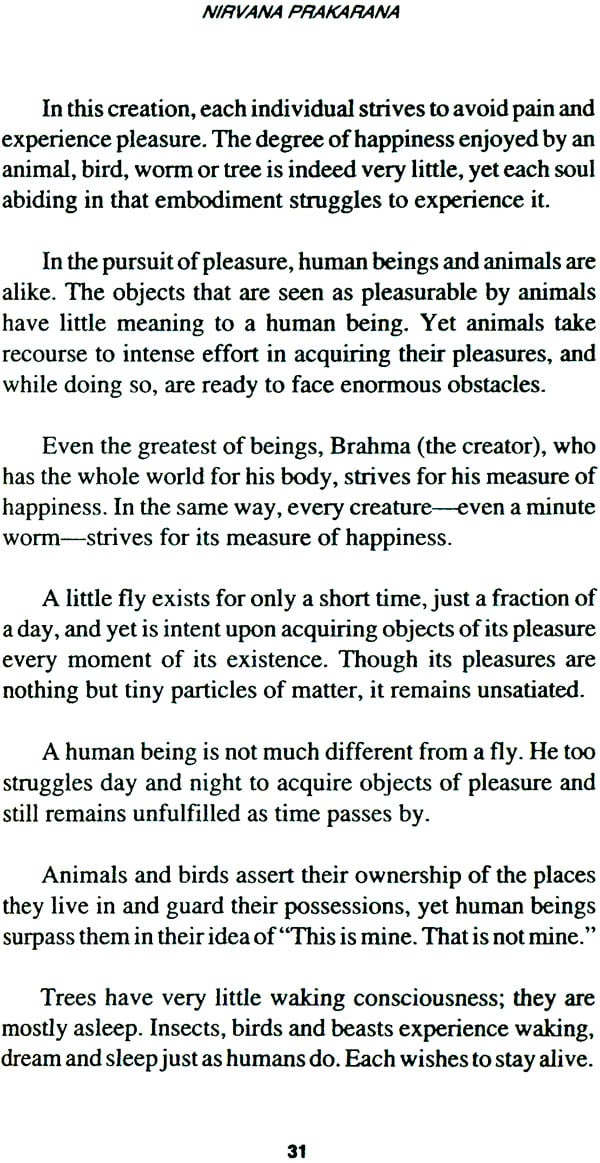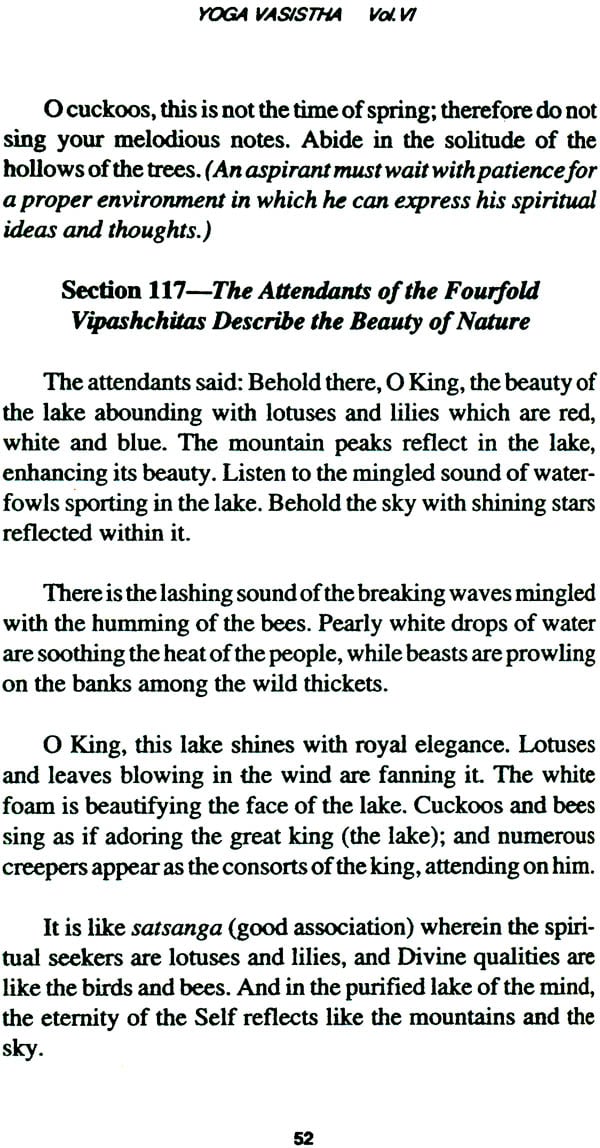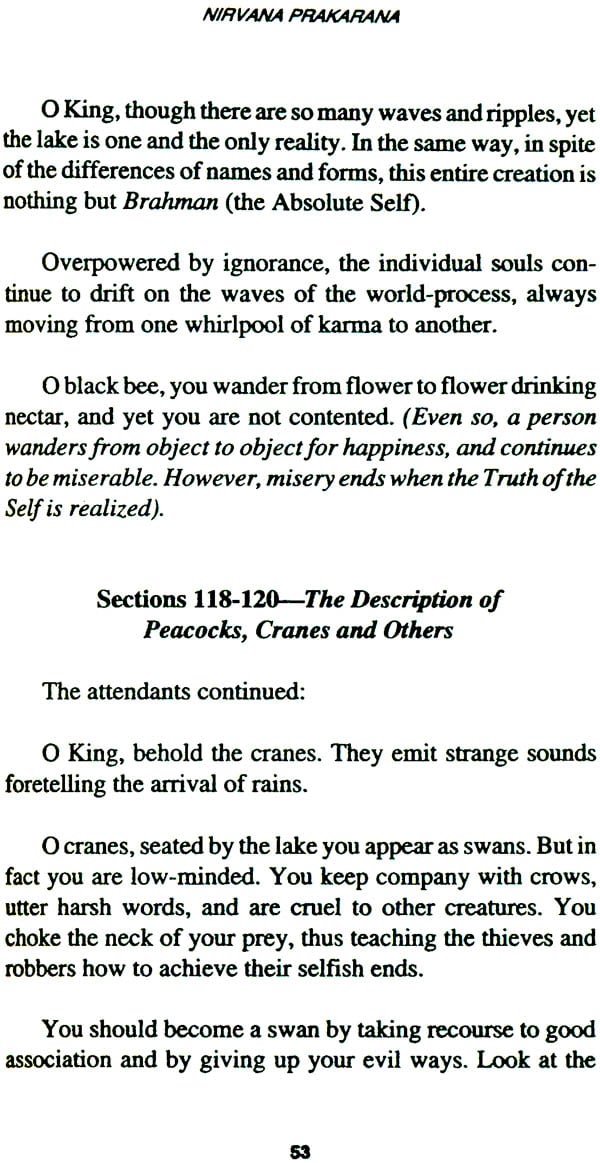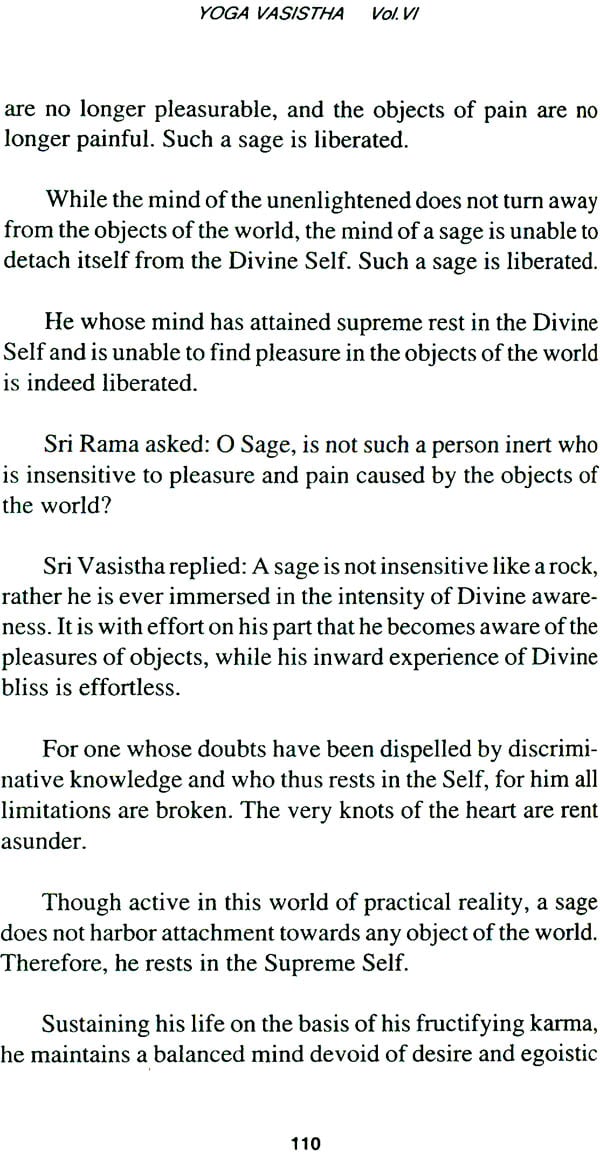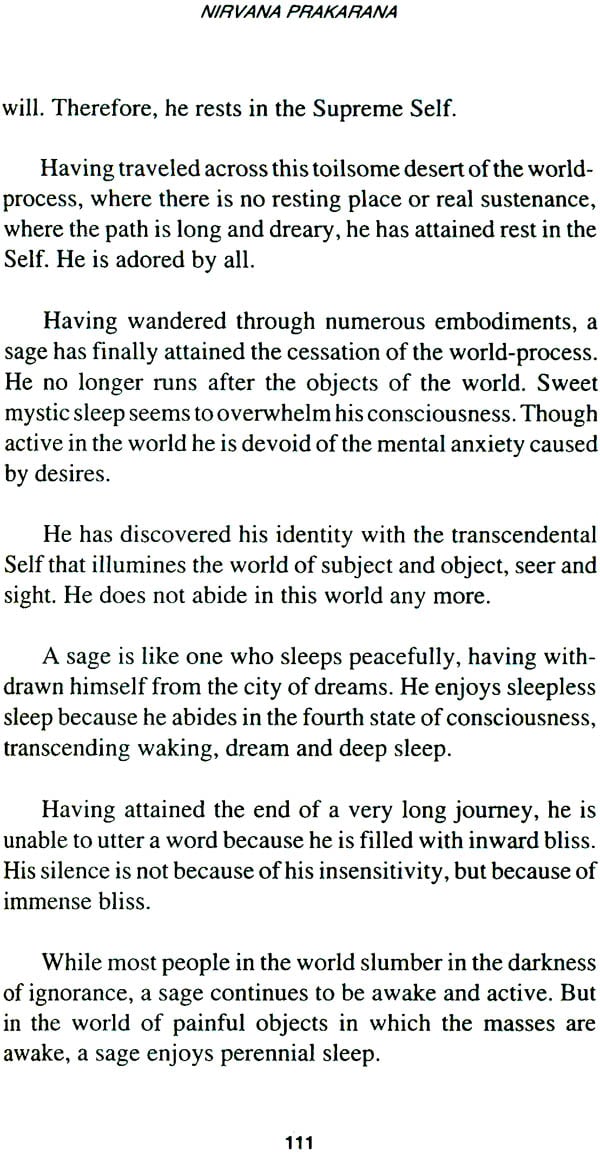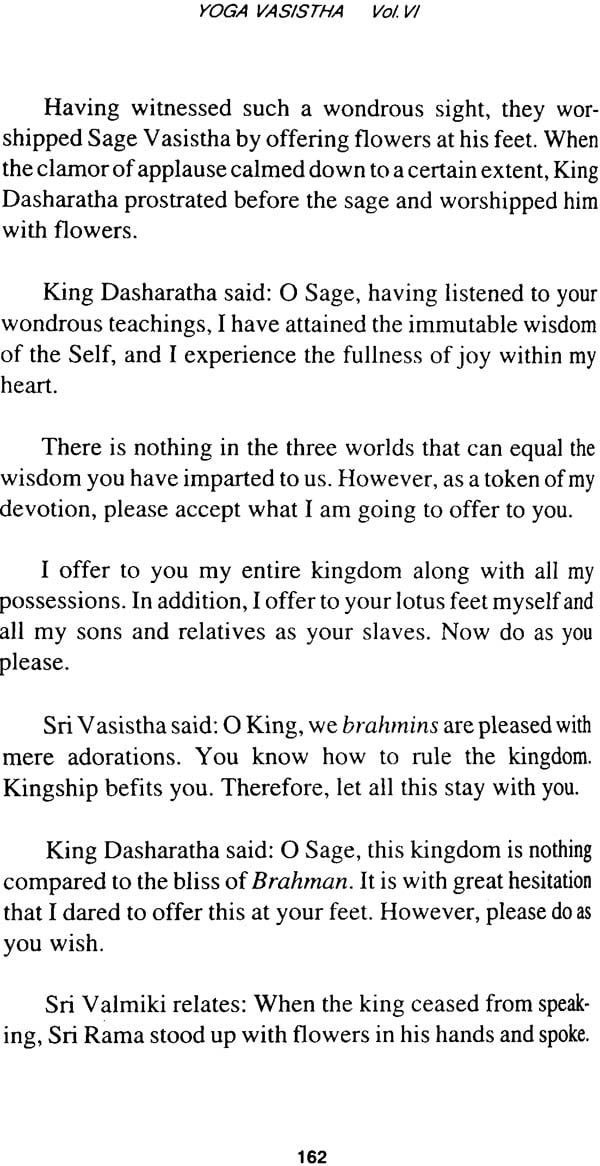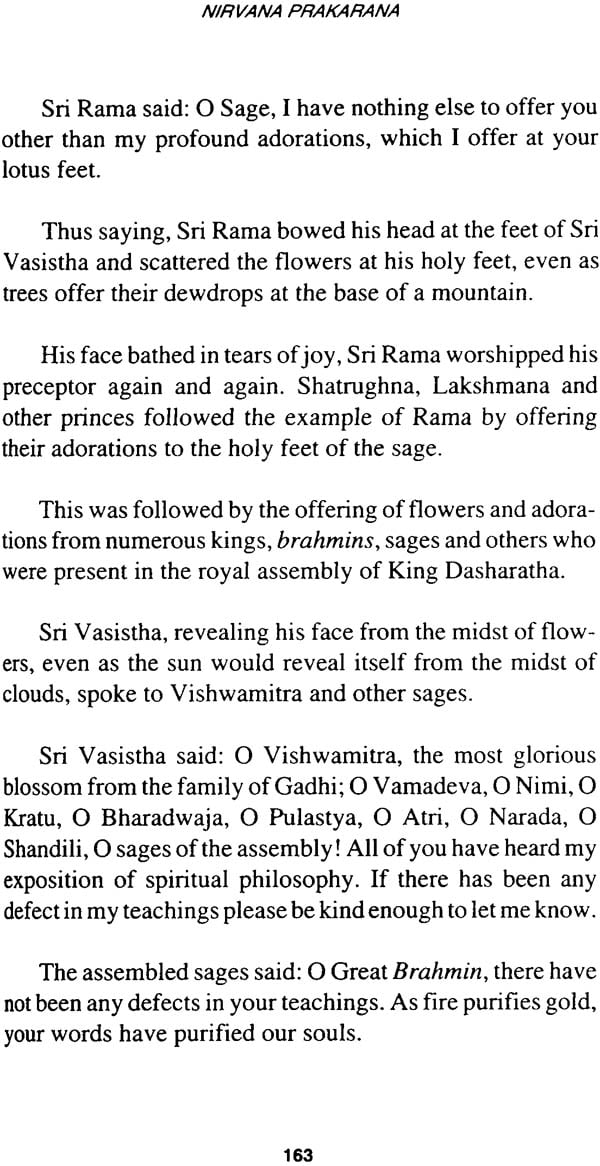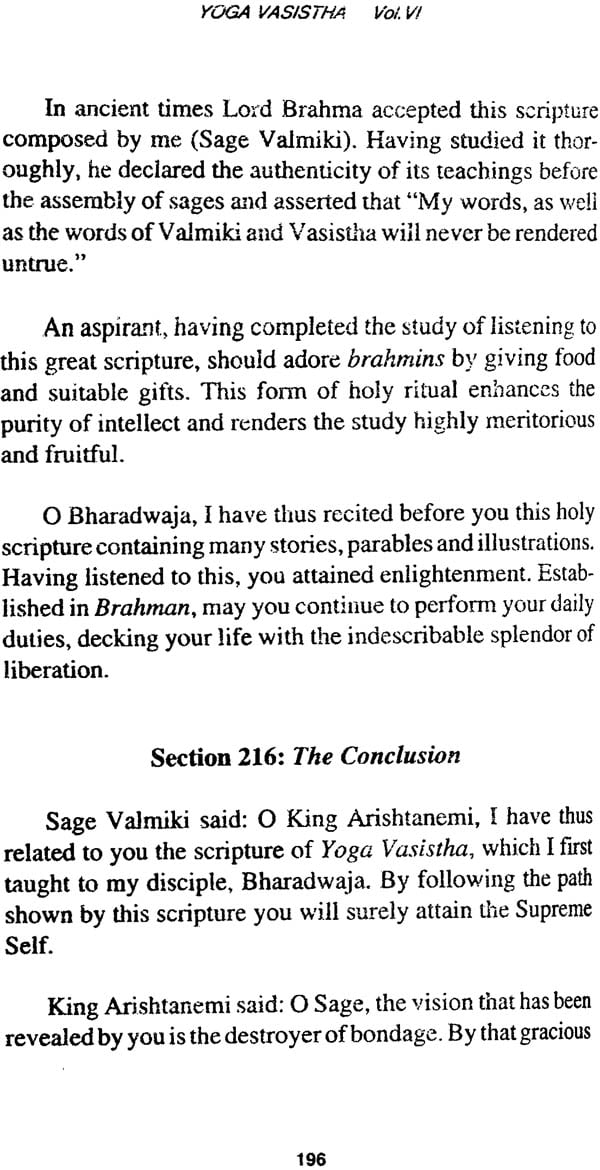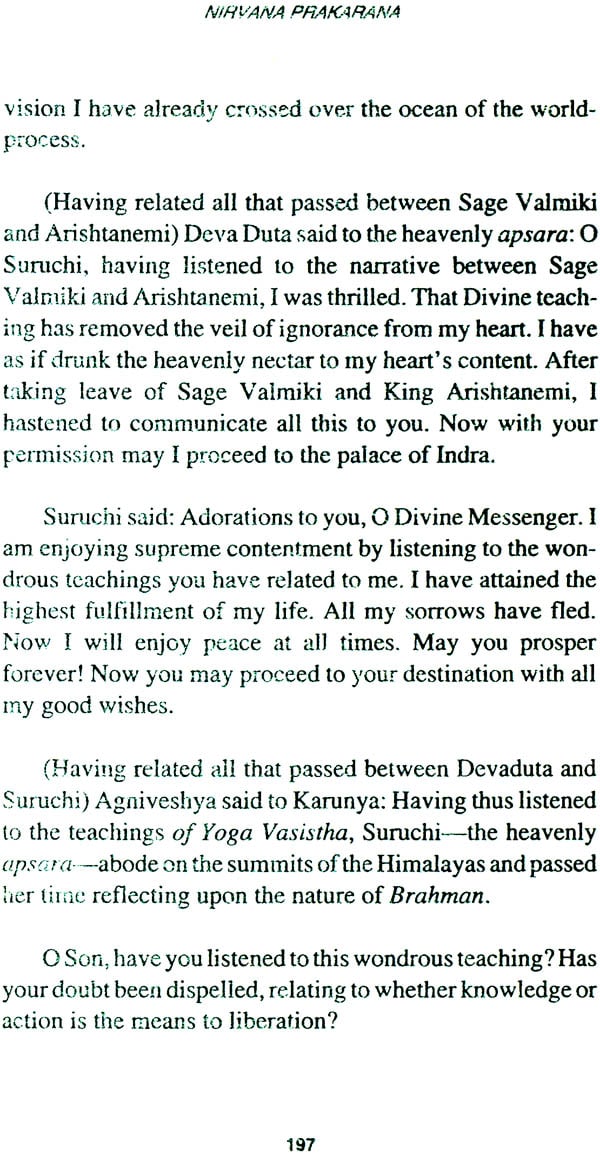
Yoga Vasistha (Set of 6 Volumes) - A Rare Book
Book Specification
| Item Code: | NAJ492 |
| Author: | Swami Jyotirmayananda |
| Publisher: | INTERNATIONAL YOGA SOCIETY |
| Language: | English |
| Edition: | 2021 |
| ISBN: | 8185883491 |
| Pages: | 1682 (90 B/W Illustrations) |
| Cover: | Paperback |
| Other Details | 8.5 inch X 5.5 inch |
| Weight | 1.70 kg |
Book Description
Volume I: Vairagya Mumukshu Utpatti (ISBN: 8185883491)
Yoga Vasistha can bring a complete transformation in human personality; even like the beggar of old fairy tales who turned into a King when a charmed golden ring fell into his hand; just so, whosoever holds this book, turning the pages with an inquisitive mind and a heart searching for truth, will discover the infinite beauty of his inner Self.
Yoga Vasistha nourishes the soul and awakens a yearning for freedom and an exquisite peace unknown before.
This unique book par excellence has been long awaited by advanced Vedantins and Yogis of India, because it is only available in rare editions of the last century. And it is what the enquiring mind of the West has been desperately needing since they heard he remarks of Schopenhauer, "In the whole world there is no study so beneficial and so elevating as that of the Upanishads. It has been the solace of my life; it will be the solace of my death." There are a few publications at present which are not sufficient to portray the total beauty and wisdom of Yoga Vasistha.
H.H. Sri Swami Jyotir Maya Nanda, internationally known lecturer and writer of over fifty books on Yoga and Vedanta philosophy, has been interpreting and commenting on Yoga Vasistha for almost 25 years: first in India for 9 years at the Yoga Vedanta Forest Academy, Sivananda Ashram, Himalayas; in Vedantic conferences in Amritsar, Ludhiana, and other parts of India, and also in Dehradun Women's College. Since coming to the west, Swamiji had been lecturing in Puerto Rico for six years, followed by his weekly lectures here in Miami. Available on tapes and cassettes, these lectures are an undying treasure.
We are presenting an abridged version of Yoga Vasistha in two volumes. The first volume contains: Vairagya Prakarana, Mumukshu Vyavahara Prakarana, and a portion of Utpatti Prakarana.
After a brief encounter with Yoga Vasistha, the reader will feel that all other books of philosophy have become like old crumbs on the table, while Yoga Vasistha stands like the sweet, vitalizing elixir of life.
If I could have only one book for some extraordinary reason to read for the rest of my life, I would choose Yoga Vasistha; just as King Shah Jehan had the choice of only one type of food-grain while he was imprisoned for life, and he chose the chickpeas (garbanzo beans) because of its nourishment and adaptability to a variety of tasty dishes.
Yoga Vasistha encompasses in its powerful literature the dramatic stories of the inner states of the mind, and like a brilliant advocate, presents its brief with a convincing voice and expert phrasing, and with its mystic strategy convinces the mind to undermine its fancies and imaginations leading to the realization that the world lies within the mind.
Nothing is more inspiring and soul-stirring as when the mind lifts itself from the quagmire of false perceptions of the senses, and sees the contents of waking, dream and deep sleep as the refractions of the Light of Consciousness filtering through the layers of egoistic illusions.
The awe-inspiring awakening of the knowledge that "You are not this body, not this mind, and not this intellect" is uplifting and produces a vital change in the overall perception of the world. it is for this reason Sages warn immature aspirants against the wrong interpretations of this grand philosophy; they emphasize the fact that the wisdom of the Yoga Vasistha must be received under the guidance of an illumined teacher. For those who are endowed with a mighty strength of intellect, and intense dispassion, Yoga Vasistha brings for them the clouds of mystic understanding that bursts into the flood of unique bliss.
Due to the unfortunate lack of knowledge of Yoga Vasistha, the intelligentsia of the West have been unable to realize the vast treasure of profound knowledge that lies hidden in this great work. Because of this reason, the wisdom of Vedanta has not been deeply understood and assimilated by them.
Yoga Vasistha in its broad spectrum encompasses topics such as: the mysteries of the soul, death and reincarnations, the psychic powers, the mystic energy known as Kundalini, the subtle operations of the unconscious mind which bring about repeated embodiments ad the techniques of spiritual enquiry and meditation.
With his deft hand and eloquent pen, Sri Swami Jyotir Maya Nanda gives to the world his most memorable writing which has been guarded as a secret mystic wealth by the Sages of India for a long time.
The greatest literatures of the world have always incorporated in their writings parables, illustrations, and stories to bring about a striking impression, even like that of a lightning flash, upon the sleeping mind in order that it may awaken sharply to the light of the truth. Yoga Vasistha abounds with these.
It is to be noted that humor and wit permeate the writings and lectures of Sri Swami Jyotir Maya Nanda. They are like the green creeper adorning the tree of liberation. A studious reader will meet for the first time a challenge to his intellect to discover the secret wealth of the Self, and to explore the mysteries of the mind.
This book, written by Sage Sri Swami Jyotir Maya Nanda, presents you with the key to heavenly bliss and perfection; and every page of this book is filled with his blessings.
May the golden sun of your eternal Self rise from behind the horizon of distractions and mental limitations and encompass you in the greatest beauty and sublime love which are the very essence of your real Self.
The Yoga Vasistha Maha-Rilmayana, one of the greatest of all Hindu scriptures, is virtually unknown in the West, due to the scarcity of its English translations.
This vast work of approximately thirty-two thousand verses (sixty-four thousand lines) supplements the epic poem, the Ramayana, which is more popularly known throughout India and the world. In the "Bala-Kanda" section of the Ramayana, it is stated that Sri Rama was given spiritual instructions by Sage Vasistha . Yoga Vasistha is that teaching. Whereas the Ramayana describes the epic life and adventures of Sri Rama, the Yoga Vasistha presents his inner realization in detail for those who wish to intensify their spiritual life and deepen their understanding.
The Yoga Vasistha is also known by the following names: Maha-Ramayana, Uttar Ramayana, Arsha Ramayana, Jnana Vasistha, Vasistha Ramayana, and Vasistha. Whatever you choose to call it, it is the earliest detailed work of Yoga- Vedanta. 'and gives a magnificently detailed exposition of the subtleties and insights of that philosophy with a majestic sweep that has never been equalled in any metaphysical work since. It was written by the great poet Valmiki (probably about 500 B.C., although maybe much earlier) in the form of dialogue between Sage Vasistha and his pupil, the young prince Rama.
Every kind of exposition is employed in its sequence - didactic instruction, answers to doubts, parables, and stories within stories, Many key points of this metaphysical instruction are touched upon over and over again, with increasingly deeper meanings. Therefore, the work appears to move in vast spirals, culminating in the Self-realization of Sri Rama.
The interlocking system of stories within stories enhances the vision of worlds within worlds, and of the infinitely complex world of the mind, itself arising within the Cosmic Mind.
In the opening stage, Sri Rama relates his growing awareness of the transiency of life and of all worldly aims. A great Vairagya (dispassion) arises, which later develops into Mumukshuttwa (longing for spiritual emancipation). Subsequently, he is fully enlightened by Sage Vasistha. In the process, every aspect of Yogic and Vedantic teaching is beautifully and fully developed.
Yoga Vasistha is divided into the following six chapters:
1) Vairagya Prakarana (Dispassion)
At Sage Vasistha's request, Sri Rama describes the cause of his mind's unusual melancholy state. He elaborates upon the transiency, essencelessness, and changing nature of all objects in this world. These vivid descriptions of the vanity of all worldly pleasures, and of the emptiness of all worldly glories. are meant to promote Vairagva (dispassion), which is the first basic requirement for treading 'the path of wisdom that leads to Self-realization.
2)Mumuksu Prakarana (Aspiration for self-realization)
This section details upon the qualifications that are necessary before one can seek immortality. One should not rely on destiny, but rather, gain an insight into the fact that the Self in him is the ceaseless source of all energy and creativity. He should befriend one of the four gatekeepers of Liberation (serenity, contentment, spiritual enquiry, and good association). With the help of that one gatekeeper, he will automatically befriend the other three, and finally, enter into the blessed palace of Liberation.
3) Utpetti Prakarana (The Origin of the World-process)
" Utpatti Prakarana" is an exposition on how the world evolved from the Absolute and is ever rooted in the Absolute. In fact. the world .15 an appearance sustained by the limitations of the mind. When these limitations are overcome by intuitive wisdom, it becomes non-existent.
4)Sthiti Prakarana (The Sustaining Reality of the Self)
This section explains how an aspirant, having attained knowledge, can abide in Brahman, even though the world continues to appear. The underlying Reality behind the ego-sense in man is the Absolute. When the illusion of duality is negated by wisdom, a Yogi lives and sports in Brahman. The Self is realized as the creator as well as the enjoyer of the unrverse.
5) Uossheme Prakarana (Quiescence of the Mind)
Herein Yoga Vasistha deals with the stupendous experience of peace that results from spiritual Enlightenment. The characteristics of a Self-realized Sage are described in glowing terms, This section also gives instructions for the removal of Ahamkara (egoism), for the promotion of equal vision, and for the attainment of absolute detachment from the world-process.
6) Nirvana Prakarana (Liberation)
This voluminous section is divided in two parts: In the first, entitled Purva Bhaga, the Yogi discovers his essential nature. He realizes his true identity as Brahman, the underlying Reality behind all individual beings, as well as the universe. He becomes all that is. In this section, Sri Rama enters into divine ecstasy.
In the second part, Uttara Bhaga, Yoga Vasistha presents the beatific vision of Nirvana (Liberation), which is the extinction of all cravings. Sage Vasistha describes his own personal experiences of Samadhi and of the majestic vision of the entire universe being nothing but the Self.
In conclusion, Sri Rama attained enlightenment. But instead of turning away from the practical duties of the world, he prepared himself to perform them even as the great Divinities who create, sustain and destroy the world - with a spirit of absolute detachment.
| Vairagya Prakarana | ||
| 1 | Prologue (sutikshna and Agasti, atc....) | 20 |
| 2 | Brahma Urges Sage Valmiki to Compose Yoga Vasistha | 34 |
| 3 | The Nature of Wisdom (The Pilgrimage of Rama) | 38 |
| 4 | The Daily Life of Rama | 42 |
| 5 | Rama's Dejection | 42 |
| 6 | The Arrival of Vishwamitra | 43 |
| 7 | Vishwamitra's Request for Rama | 45 |
| 8 | Dasharatha is in Distress | 47 |
| 9 | Vishwamitra's Request for Rama | 48 |
| 10 | Rama's Distressing condition | 50 |
| 11 | Sri Rama is Brought to Vishwamitra | 51 |
| 12 | The Reason for Rama's distress | 52 |
| 13 | Denunciation of Wealth | 54 |
| 14 | The Vanity of Life | 57 |
| 15 | Denunciation of Egoism | 59 |
| 16 | Denunciation of the Mind | 60 |
| 17 | Denunciation of Craving | 62 |
| 18 | Denunciation of the Body | 64 |
| 19 | Denunciation of the Childhood Stage | 68 |
| 20 | The Evils of Youth | 70 |
| 21 | Denunciation of Sex and Passion | 73 |
| 22 | Denunciation of Old Age | 75 |
| 23 | Denunciation of Time | 79 |
| 24 | The Transitoriness of the world | 83 |
| 25 | The Dance of the Time Spirit | 83 |
| 26 | The Evils of Perishability | 84 |
| 27 | Denunciation of all Objects that obstruct Self-realization | 87 |
| 28 | The Transient Nature of All Sense | 91 |
| 29 | The Essencelessness of All Object | 95 |
| 30 | Request for Spiritual Instruction | 97 |
| 31 | Spiritual Questions | 10 |
| 32 | Sri Rama is praised by the Siddhas | 103 |
| 33 | Sri Rama is Praised by the Sages | 103 |
| Mumukshu Vyavahara Prakarana | ||
| 1 | Sri Shuka Goes to King Janaka | 105 |
| 2 | Sage Vishwamitra Requests Sage Vasistha to instruct Sri Rama | 110 |
| 3 | The Nature of the World-process in the Three Periods of Time | 112 |
| 4 | The Glory of Self-effort | 114 |
| 5 | The Power of Self-effort | 118 |
| 6 | The Negation of Destiny | 121 |
| 7 | Predominance of Self-effort | 126 |
| 8 | The Illusion of Destiny | 129 |
| 9 | The Illusoriness of Actions and the Reality of the Self | 131 |
| 10 | The Origin of Sage Vasistha | 135 |
| 11 | The Descent of Spiritual Wisdom | 139 |
| 12 | The Evils of the World process and the Glory of Wisdom | 143 |
| 13 | Introduction to the Four Gatekeepers The First Gatekeeper: Shama (Serenity) | 145 |
| 14 | The Second Gatekeeper: Vichara (Spiritual Enquiry) | 149 |
| 15 | The third Gatekeeper: Santosh (Contentment) | 153 |
| 16 | The Fourth Gatekeeper: Satsanga (Good Association) | 154 |
| 17 | The General Plan of Yoga Vasistha | 157 |
| 18 | The Special Qualities of Yoga Vasistha | 159 |
| 19 | Brahman is Revealed by Right Knowledge (Pramana) | 163 |
| 20 | The Conduct of Enlightened Sages | 165 |
| Utpatti Prakarana | ||
| 1 | The Cause of Bondage | 168 |
| 2 | The Ignorant Are Devoured by Death | 172 |
| 3 | Brahma's Creation is Mental in | 174 |
| 4 | The Nature of the Mind | 176 |
| 5 | The Divine Self is the Root of the Mind and the world | 178 |
| 6 | The Self is Realized Through Wisdom and Not Through Action | 181 |
| 7 | The Absolute without the Limitations of the World - process | 184 |
| 8 | The Glory of Spiritual Scriptures | 188 |
| 9 | The Characteristics of a Liberated Sage | 191 |
| 10 | The Paradoxical Description of Brahman | 196 |
| 11 | The World as a Mental Illusion | 201 |
| 12 | The Creation of the Universe | 202 |
| 13 | Brahman Becomes the Jiva (Individual Soul) through illusion | 204 |
| 14 | It is Brahman That Manifests as the Universe | 206 |
| 15 | The Story of Lila Commences | 210 |
| 16 | There is a Tragic End to the Enjoyments of This World | 211 |
| 17 | The Spirit of King Padma Enjoys a Different and Becomes king Viduratha | 215 |
| 18 | Both the World of Padma and the World of Padma's Spirit, Viduratha, Are Illusory | 217 |
| 19 | The Story of Vasistha and Arundhati (The Past Lives of Padma and Lila) | 219 |
| 20 | Life Sees the World of Her Previous Birth (Insight into the Illusory Nature of the World) | 220 |
| 21 | Teachings of Goddess Saraswati Expounding That All This is the Pure Self | 225 |
| 22 | The Way to Destroy the Vasanas of the Mind | 229 |
| 23 - 26 | Lila and Goddess Saraswati Travel with Their Astral Bodies to the World of Lils's Previous Existence | 232 |
| 27 | Lila's Past Lives | 236 |
| 28 29 | Lils Remembers More Details about Her Previous Embodiment in the Form of Arundhati | 239 |
| 30 - 39 | Lila Enters into the World of Viduratha and Writnesses a Terrible Battle | 242 |
| 40 | The nature of the Subtle Body | 245 |
| 41 | King Viduratha Wakes Up to Find Two Goddesses Before Him | 249 |
| 42 - 44 | Ignorance Lend: Reality to Waking and Dream States | 252 |
| 45 | Goddess Saraswati Grants a Boon to Lila (Viduratha's Queen) | 255 |
| 46 - 51 | King Viduratha Fights with King Sindhu | 256 |
| 52 - 53 | King Viduratha Dies and Lila-2 Reaches the World | 260 |
| 54 | The Peocess of Death, and the Karmas That Determine the Life Span of an Individual | 264 |
| 55 | Experiences After Death | 268 |
| 56 - 58 | The Departure of Viduratha | 270 |
| 59 | Conclusion of the Story of Lila | 273 |
| 60 | The Relativity of Time and Space | 276 |
| 61 | The Vanity of Objects | 280 |
| 62 | The Vision That Leads to Liberation | 283 |
| 63 | Brahman Appears as the World - peocess through Maya | 285 |
| 64 - 65 | Consciousness is the Reality Behind the Mind and Objects | 286 |
In the "Bala-Kanda" section of the Ramayana it is stated that Sri Rama was given spiritual instructions by Sage Vasistha. Yoga Vasistha, a complete and separate work in itself, is that teaching. While the Ramayana, the epic poem more popularly known throughout India and the world, describes the life and adventures of Sri Rama, the Yoga Vasistha presents his inner realization in detail for those who wish to intensify their spiritual life and deepen their understanding. A vast work of approximately 32,000 verses, the Yoga Vasistha was written by the great poet-sage Valmiki, as was the Ramayana, about 500 B.C. or earlier.
The Yoga Vasistha, which is virtually unknown in the West due to the scarcity of its English translations, is also known by the names of Maha-Ramayana, Uttar Ramayana, Arsha Ramayana, Jnana Vasistha, Vasistha Ramayana, and Vasistha. But whatever you choose to call it, it is the earliest detailed work of Yoga-Vedanta and gives a magnificent exposition of the subtleties and insights of that philosophy with a majestic sweep that has never been equalled in any metaphysical work since.
Every kind of exposition is employed in its presentation - didactic instruction, answers to doubts, parables, and stories within stories. Here, for example, the interlocking system of stories within stories enhances the vision of worlds within worlds, and of the infinitely complex world of the mind, itself arising from the Cosmic Mind. Many key points of this metaphysical instruction are touched upon over and over again with increasingly deeper meanings. Therefore the work appears to move in vast spirals, ultimately culminating in the Self- realization of Sri Rama.
In "Vairagya Prakarana" of Volume l it will be remembered that Sage Vasistha asked Sri Rama to express the reasons for his depressed state of mind. At this, Sri Rama elaborated upon the transiency and essencelessness of all objects of the world. All that he once thought to be of value and a source of happiness has, through the vision of his penetrative intellect, become nothing but a source of emptiness and misery.
In the first section, therefore, Sri Rama has taken what is normally the most valued aspects of life and has shown how illusory they are. The purpose here is to promote dispassion (Vairagya) in the aspirant. Such Vairagya considers all pleasures of the world, from the lowest form of life to the highest - that of Brahma the Creator- as insignificant and illusory. This is the first and fundamental requirement on the path of wisdom that leads to Self-realization.
In the second section, "Mumukshu Prakarana," it has been shown that certain qualifications are necessary for an aspirant before he can effectively move on the path towards the state of immortality or Self-realization. Sage Vasistha, therefore, elaborated on the four most important qualifications-those of Serenity, Contentment, Spiritual Enquiry and Good Association.
In addition, "Mumukshu Prakarana" elaborated on how the aspirant should not rely on destiny, rather on his own self-effort. The Self within is unlimited, and each person has that same potential within - all that is needed to unlock that infinite potential and creativity is repeated self-effort.
In "Utpatti Prakarana," Sage Vasistha has shown how the world has evolved from and is sustained by the Absolute through the limitations of the mind. And since the world is merely a protection of the mind conditioned by ignorance, when ignorance is overcome by intuitive wisdom, mind re- discovers its unity with the Cosmic Mind and the Individual merges into the Absolute. At this point, the entire world-process is remembered to be no- thing but a long dream of the mind from which one has awaken. It was in this section that the first volume ended and the present volume now continues.
After completing "Utpatti Prakarana," Sage Vasistha goes into "Sthiti Prakarana" which deals with the sustaining reality of the Self, and then on into "Upashama Prakarana," the topic dealing with the quiesence of the mind. Volume III will pick up here and will continue on into the last and final section, "Nirvana Prakarana," the topic dealing with the final stage of Sri Rama's instruction from Sage Vasistha, and his ultimate Enlightenment.
| Dedication | 5 | |
| Publishers Note | 6 | |
| Introduction | 15 | |
| Invocation | 19 | |
| UTPATTI PRAKARANA | ||
| 66 | The Mystic Art of Destroying the Mind | 21 |
| 67 | The Nature of the Soul | 23 |
| 68-83 | The Story of Karkati | 28 |
| 84 | Differences Exist Merely in Nature | 40 |
| 85 | To His Amazement, Brahma Sees Ten World Systems | 42 |
| 86 | The Ten Sons of Indu Practise Meditation | 44 |
| 87 | The Sons of Indu Become Creators of World Systems | 45 |
| 88 | Brahma Creates the World in the Spirit of Detachment | 46 |
| 89 | The Story of Indra and Ahalya | 47 |
| 90 | Sage Bharata Destroys their Bodies by Pronouncing a Curse | 49 |
| 91 | The Universe as a Creation of Mind | 51 |
| 92 | The Power of the Mind | 52 |
| 93 | The Illusoriness of Creation | 56 |
| 94 | Fourteen Classes of Jivas | 57 |
| 95 | The Unity of Chitta and Action | 60 |
| 96 | The Many Names of the Mind | 62 |
| 97 | The World as a Creation of the Limited Mind | 67 |
| 98 | The Story of Chitta as a Strange Spirit | 70 |
| 99 | The Mystic Meaning of the Story of the Strange Spirit | 73 |
| 100 | The Omnipotence of Brahman | 75 |
| 101 | The World as a Tale Told to a Child | 79 |
| 102 | The Immutability of the Self | 81 |
| 103 | The Evils Created by the Unenlightened Mind | 86 |
| 104-105 | King Lavana and the Magician | 89 |
| 106 | King Lavana Tells of His Experiences during the State of Trance | 90 |
| 107-109 | King Lavana Continues to Relate the Story of His Life as a Chandala | 93 |
| 110 | The Amazing Powers of the Mind | 96 |
| 111 | The Secrets of Controlling the Mind | 100 |
| 112 | The Technique of Renouncing the Vasanas of the Mind | 103 |
| 113 | The Knowledge of Brahman that Annihilates Vasanas | 105 |
| 114 | The Destruction of Avidya through the Knowledge of the Self | 103 |
| 115 | Sri Rama's Wonder about the Cause of King Ravana's Misery | 111 |
| 116 | The Fruit of Mental Sacrifice Performed by King Lavana | 113 |
| 117 | The Seven Stages of Ignorance | 115 |
| 118 | The Seven Stages of Knowledge | 120 |
| 119 | The Method of Attaining the States of Wisdom | 124 |
| 120 | King Lavana Visits the Lands in the Vindhyas | 127 |
| 121 | The Illusoriness of the World-process | 123 |
| 122 | The Practice of the Seven States of Wisdom | 131 |
| STHITI PFIAKARANA | ||
| 1 | The World as a Mysterious Painting | 139 |
| 2 | The Non-duality of the Self or the Absolute Bliss | 141 |
| 3 | The Endless World-process of the ignorant | 142 |
| 4 | The Disappearance of the World-process through the Annihilation Of the Mind and Senses | 143 |
| 5-8 | Begin the Story of Shukracharya illustrating the World within the Mind | 145 |
| 9-10 | The State of the Body of Shukracharya | 149 |
| 11-12 | The World as a Mental Spirit | 152 |
| 13 | The Time-spirit Explains the Powers of the Mind | 156 |
| 14 | Shukracharya is Awakened from Samadhi | 157 |
| 15 | The Brahmin Sees His Previous Body as Shukracharya | 153 |
| 16 | Shukracharya Enters His Original Body and Lives as a Liberated Sage | 160 |
| 17 | The Glory of Pure Mind | 161 |
| 18 | Pure and impure Minds | 164 |
| 19 | The Essence that Transcends the Three States of Consciousness | 167 |
| 20 | The World-process as a Projection of the Chitta | 170 |
| 21 | An impure Mind Sustains Conflicting Views | 172 |
| 22 | The Qualities that Characterize Self-realization | 176 |
| 23 | The Sovereignty of a Sage | 179 |
| 24 | The Importance of Attaining Victory over the Senses | 134 |
| 25-31 | The Story of Dama, Vyala and Kata | 135 |
| 32-33 | The Righteous Conduct That Leads to Liberation | 139 |
| 34 | The Story of Bhima, Bhasa and Dridha | 195 |
| 35 | The Methods of Attaining Mental Peace | 198 |
| 36-40 | From the State of Bondage to the State of Liberation | 205 |
| 41 | Maya or Cosmic Illusion | 211 |
| 42 | Alt-powerful Brahman Assumes the Role of Powerless Souls | 213 |
| 43 | The Souls Caught in the Wheel of the World-process | 215 |
| 44 | The Uniqueness of Liberation | 218 |
| 45 | The illusory. Mental Nature of the World-process | 220 |
| 46 | The Qualities of a Sage | 223 |
| 47 | Numerous World systems Projected by Maya | 225 |
| 48-51 | The Story of Sage Dashura | 227 |
| 52-53 | The Parable of King Khottha | 231 |
| 54-55 | The Nature of Samkalpa and the Method of Eradicating It | 234 |
| 56 | Negation of identification with the World process | 237 |
| 57 | The Method of Destroying Vasanas | 239 |
| 58 | The Enlightenment of Kacha | 243 |
| 59 | The Emptiness of Sense enjoyments | 246 |
| 60-61 | Rajas-Satwic Souls | 246 |
| 62 | The Qualities that Adorn an Aspirant | 248 |
| UPASHAMA PRAKARANA | ||
| 1-2 | Reflections of Sri Rama | 251 |
| 3-4 | Sri Vasistha Receives Praises from King Dasharatha and Rama | 255 |
| 5 | The Mystic Art of Eradicating the World process | 257 |
| 6 | Gradual Ascent Towards Liberation | 261 |
| 7-8 | Song of the Siddhas | 213 |
| 9 | King Janaka Meditates upon the Significance of the Songs of the Siddhas | 266 |
| 10 | King Janaka Practices Silent Reflection | 271 |
| 11 | The King Continues to Enlighten His Mind | 273 |
| 12 | King Janaka Abides in the State of Liberation | 275 |
| 13 | The Methods of Mastering the Mind | 278 |
| Dedication | 5 | |
| Publisher's Note | 7 | |
| Introduction | 15 | |
| UPASHAMA PRAKARANA | ||
| 14 | The Means of Negating the Mind | 21 |
| 15 | Craving as the Source of All Evils | 25 |
| 16 | Two Aspected Renunciation of Vasana | 27 |
| 17 | Affirmations That Promote Liberation | 29 |
| 18 | The Cessation of All Misery | 32 |
| 19 | The Story of Punya and Pavana | 36 |
| 20 | Punya Speaks of the Cessation of Cravings | 42 |
| 21 | Liberation Consists of The Cessation of Cravings | 42 |
| 22 | King Bali's Dispassion and His Recollection of the Teachings He Received from His Father | 45 |
| 23 | The Story of the King and His All-powerful Minister | 49 |
| 24 | The Means of Defeating the Minister | 52 |
| 25 | The Rising Moon of Wisdom in the Heart of King Bali | 56 |
| 26 | Shukracharya Gives His Brief Message | 57 |
| 27 | King Bali Practices Reflection and Enters into Samadhi | 60 |
| 28 | Sage Shukracharya Consoles the Demons | 62 |
| 29 | Bali Attains Liberation in Life | 64 |
| 30-31 | The Rise of Demon Hiranyakashipu, His Destruction, and His Son Prahlad's Devotion | 69 |
| 32 | King Prahlad Performs Worship of Lord Vishnu | 72 |
| 33 | The Unfoldment of Divine Virtues in Prahlad and the Grace of Lord Vishnu | 75 |
| 34 | Prahlad Attains Enlightenment | 78 |
| 35 | Reflections and Experiences of King Prahlad | 83 |
| 36 | Prahlad Adores the Supreme Beloved | 91 |
| 37-39 | Lord Vishnu awakens Prahlad from Samadhi | 97 |
| 40 | Lord Vishnu Enlightens the Demon-King Prahlad | 100 |
| 41 | The Demon-King Prahlad is Blessed by Lord Vishnu | 103 |
| 42 | Insight into the Prarabdha of the Sages | 105 |
| 43 | Self-effort of the Individual Secures Divine Grace | 107 |
| 44 | The Story of Gadhi | 109 |
| 45 | Gadhi Witnesses Himself Being Born as a Chandala | 111 |
| 46 | Katanja Being Discovered as a Chandala | 113 |
| 47 | Gadhi Hears the Story of Kira Country | 116 |
| 48 | Gadhi Visits the Country of Kira | 118 |
| 49 | Gadhi Finally Attains Enlightenment | 119 |
| 50 | The Methods of Controlling the Mind | 124 |
| 51 | The Story of Sage Uddalaka: Mind and its Distractions | 131 |
| 52 | Sri Uddalaka Practises Spiritual Enquiry | 137 |
| 53 | The Self is Unaffected by the Subtle Desires | 146 |
| 54 | Sage Uddalaka's Spiritual Practice | 153 |
| 55 | The Liberation of Sage Uddalaka | 157 |
| 56 | The Samadhi of a Sage | 159 |
| 57 | The Apparent Externalization of the Self | 165 |
| 58 | King Suraghu Develops Dispassion | 167 |
| 59 | King Suraghu Develops Dispassion | 171 |
| 60 | King Suraghu after Enlightenment | 174 |
| 61 | King Suraghu Meets King Parigha | 175 |
| 62 | The Nature of Samadhi | 178 |
| 63 | Praised by Parigha, King Suraghu Describes His Spiritual State | 181 |
| 64 | Methods of Overcoming the Defects of the Mind | 183 |
| 0 | The Story of Bhasa and Vilasa | 187 |
| 67 | Attachment As the Cause of Bondage | 193 |
| 68 | Characteristics of Attachment and Detachment | 196 |
| 69 | The Manner in which the mind is Reduced to Pure Consciousness | 202 |
| 70 | The Glory of Detachment | 203 |
| 71 | The Glorious State of Turiya | 207 |
| 72 | Grief is Neither in the Body nor in the Self | 214 |
| 73 | Three Types of Ego | 218 |
| 74 | Enlightenment Leads to Perfection | 221 |
| 75 | Examples of Liberated Sages | 230 |
| 76 | Crossing the Ocean of the World-Process | 234 |
| 77 | A Garland of Heavenly Virtues that Adorn a Sage | 235 |
| 78 | The Methods of Destroying the Chitta | 241 |
| 79 | Destruction of the Chitta Through Wisdom | 248 |
| 80 | Spiritual Enquiry That Promotes Vairagya | 250 |
| 81 | Negation of the Chitta | 255 |
| 82 | The Practice of Enquiry by Sage Vitahavya | 256 |
| 83 | Bliss of the Self Transcending the Chitta and the Indriyas | 263 |
| 84 | Experiences of Vitahavya during the State of Samadhi | 267 |
| 85 | The Revival of the Body of Sage Vitahavya | 270 |
| 86 | Characteristics of Jivan Mukti and Preparation for Videha Mukti | 271 |
| 87 | Sage Vitahavya Attains Videha Mukti | 276 |
| 88-89 | Dissolution of the Elements in Videha Mukti and the Glory of Liberation | 278 |
| 90 | Two Types of Chitta-Nash | 280 |
| 91 | The Cause of the world-Process | 285 |
| 92 | Disciplines Leading to Wisdom | 290 |
| 93 | The Glory of spiritual Enquiry and the Attainment of Wisdom | 294 |
| Dedication | 5 | |
| Publisher's Note | 5 | |
| Introduction | 15 | |
| NIRVANA PRAKARANA-PURVARDHA | ||
| 1 | The Dispersal of the Assembly in Ayodhya | 21 |
| 2 | The Dissolution of the Chitta | 24 |
| 3 | The Cessation of the Delusion of Duality | 28 |
| 4 | The Cessation of the Chitta | 30 |
| 5 | Sri Rama Speaks of His Experiences | 32 |
| 6 | The Negation of the Body-Idea | 34 |
| 7 | Extensions of Ignorance | 39 |
| 8 | Ignorance Compared to a Creeper | 43 |
| 9 | The Division of the Three Gunas | 46 |
| 10 | Enquiry Leading to the Removal of Ignorance | 47 |
| 11 | The Vision of "All This Is Brahman" | 51 |
| 12 | The Divine State of the Sages | 58 |
| 13 | Two Methods of Destroying the Vasanas | 51 |
| 14-16 | The Story of Kaka Bhushunda Begins | 62 |
| 17-19 | Story of Birth and Enlightenment of Kaka Bhushunda | 67 |
| 20 | The Similarity of Worlds in Every Kalpa | 72 |
| 21 | Description of the Kalpa Tree and the Mysterious Creation | 74 |
| 22 | Kaka Bhushunda Remembers Similar Events in Numerous Cycles of Creation | 78 |
| 23 | The Mystic Method of Mastering Death | 80 |
| 24 | The Mystic Path of Controlling the Pranas | 84 |
| 25 | Meditation on Spontaneous Functions of Prana and Apana | 87 |
| 26 | The Deathless State Attained by Kaka Bhushunda | 91 |
| 27 | Kaka Bhushunda Is Praised by Vasistha | 97 |
| 28 | The Illusoriness of the Body and the World | 98 |
| 29 | Sage Vasistha Recalls Lord Shiva's Instructions | 104 |
| 30 | The Mystic Art of Worshipping the Supreme Self | 114 |
| 31 | Description of Consciousness through the Negation of the World-process | 121 |
| 32 | Consciousness Involved in the Process of Embodiment | 126 |
| 33 | The Negation of Multiplicity by Spiritual Enquiry | 130 |
| 34 | Transcending the Three States of Consciousness | 134 |
| 35 | The Supreme Self as the Progenitor of all Gods | 137 |
| 36 | The Glorious Attributes of Pure Consciousness | 139 |
| 37 | The Dance of the Time Spirit | 141 |
| 38 | The Worship of God through Objective Meditation | 184 |
| 39 | The Subjective Worship of Lord Shiva | 148 |
| 40 | The Supreme Self As the Essence of Gods | 151 |
| 41 | and 42. The Falsity of the World | 154 |
| 42 | Sri Rama Enjoys Spiritual Bliss | 157 |
| 43 | Sri Rama Enjoys Spiritual Bliss | 157 |
| 44 | The Method of Destroying Attachments | 159 |
| 45 | Brahman Compared to a Bilwa Fruit | 161 |
| 46 | Brahman Compared to a Painting-in-a-Fruit | 162 |
| 47 | Brahman as the Mass of Consciousness | 164 |
| 48 | The innermost Self and Brahman Are Identical | 166 |
| 49 | Enquiry into the Nature of the World-process | 167 |
| 50 | The Illusoriness of the Subtle Body | 169 |
| 51 | The illusion of the Senses | 171 |
| 52 | Arjunakhyan-Story of Krishna's Teachings to Arjuna | 175 |
| 53 | Lord Krishna's Instructions | 178 |
| 54 | Instructions1orAttaining Freedom from Bondage | 182 |
| 55 | It is the Knowledge of the Self that Confers Release | 187 |
| 56 | The Means to Liberation | 192 |
| 57 | The Vision That Ends All Vasanas | 195 |
| 58 | Arjuna Attains Enlightenment | 197 |
| 59 | The Vision of a Liberated Sage | 199 |
| 60 | The Glory of The Self | 203 |
| 61 | The Long Dream of the World-process | 205 |
| 62 | The Story of Jivata | 207 |
| 63 | The Story of Jivata Continues | 208 |
| (Mystic Meaning of the Story of Jivata) | 210 | |
| 64 | The Attainment of Shivahood | 212 |
| 65 | The Story of the Mendicant Applies to All Souls | 215 |
| 66 | Similarity in Creation | 216 |
| 67 | Knowledge of the Truth Destroys Bondage | 287 |
| 68 | Four Types of Silence | 218 |
| 69 | Conclusion of the Story of the Mendicant | 223 |
| 70 | The Dialogue between the King and the Vetala | 224 |
| 71 | Answers to the Questions of the Vetala | 227 |
| 72 | The King Continues to Give Answers | 228 |
| (Mystic Meaning of the Story of the Vetala) | 230 | |
| 73 - 74 | King Bhagiratha's Story | 232 |
| 75 | King Bhagiratha's Liberation | 235 |
| 76 | Bhagiratha Resumes the Rulership of His Kingdom | 237 |
| 77 | The Story of Queen Chudala and King Shikhidhwaja | 240 |
| 78 | Queen Chudala Attains Wisdom | 241 |
| 79 | Shikhidhwaja Notices the Spiritual Beauty of Chudala | 246 |
| 80 | Yogic Techniques for Attaining Psychic Powers | 248 |
| 81 | Kundalini Shakti and the Cessation of Diseases | 250 |
| 82 | Description of Siddhis in the Story of Queen Chudala | 205 |
| 83 | The Parable of Kirata | 257 |
| 84 | King Shikhidhwaja Enters Forest for Attaining Liberation | 258 |
| 85 | Queen Chudala Observes the Inner State of the King | 261 |
| 86 | Chudala Tells a Fictitious Story of Her Identity as Kumbha Muni | 257 |
| 87 | King Shikhidhwaja Seeks Spiritual Instructions from Kumbha Muni (Queen Chudala) | 268 |
| 88 | Parable of Chintamani (Wish-yielding Jewel) | 272 |
| 89 | The Parable of the Elephant | 274 |
| 90 | Meaning of the Parable of the Wish-yielding Jewel | 276 |
| 91 | Meaning of the Parable of the Elephant from the Vindhya Mountains | 276 |
| 92 | The King Endeavors to Renounce All His Possessions | 277 |
| 93 | Kumbha Muni Teaches the Secret of Renunciation | 279 |
| 94 | Kumbha Muni Gives Insight into Renunciation | 284 |
| 95 | How to Remove Ignorance | 288 |
| 96 | Negation of the World-process | 290 |
| 97 | Pure Consciousness Is the Reality behind All Names and Forms | 291 |
| 98 | Negation of the Chitta | 292 |
| 99 | Kumbha Muni Continues to Enlighten Shikhidhwaja | 293 |
| 100 | Brahman is the Self-effulgent Reality | 294 |
| 101 | Shikhidhwaja Attains Enlightenment | 286 |
| 102 | Kumbha Muni Disappears, Leaving the King in a Profound State of Meditation | 299 |
| 103 | Queen Chudala Awakens the King from Samadhi | 299 |
| 104 | Kumbha Muni Plans to Test the Firmness of King Shikhidhwaja's Realization | 301 |
| 105 | Kumbha Muni Relates a False Story | 302 |
| 106 | Kumbha Muni (Chudala) Assumes the Form of Madanika and Marries Shikhidhwaja | 303 |
| 107 | Queen Chudala tests the spiritual attainment of King Shikhidhwaja | 305 |
| 108 | Queen Chudala Creates the illusion of Madanika's Infidelity | 307 |
| 109 | King Exercises His Intuitive Mind and Praises Chudala | 309 |
| 110 | The King and Queen Rule Their Kingdom as Enlightened Sages | 315 |
| NIRVANA PRAKARANA-PURVARDHA | ||
| 111 | The Divine Sage Brihaspati Teaches His Son, Kacha | 21 |
| 112 | The Parable of a False Being | 24 |
| 113 | The Meaning of False Purusha | 26 |
| 114 | The Negation of the Concepts of Existence and Non-existence | 28 |
| 115 | The Characteristics of a Liberated Sage | 30 |
| 116 | Characteristics of a Dissolving Chitta | 35 |
| 117 | Prajapati Manu Instructs Ikshwaku | 37 |
| 118 | Methods of Attaining Self-realization | 38 |
| 119 | The Powers of Ignorance and Knowledge | 40 |
| 120 | Seven States of Wisdom Taught by Sage Manu | 41 |
| 121 | Two Types of Mental Attitudes | 43 |
| 122 | The Daily Conduct of an Enlightened Sage | 45 |
| 123 | Why Siddhis Are Not Desired by a Sage | 46 |
| 124 | Bondage and Liberation for the Individual Soul | 47 |
| 125 | Steadiness in Turiya Consciousness | 50 |
| 126 | The Seven States of Wisdom | 52 |
| 127 | Sage Valmiki Summarizes the Teachings for His Disciple Bharadwaja | 58 |
| 128 | The Path of Laya Yoga and Sri Rama's Awakening | 61 |
| NIRVANA PRAKARANA-UTTARARDHA | ||
| 1 | Eradication of Desire in a Jivan Mukta | 72 |
| 2 | The World is Full of Shiva | 76 |
| 3 | Eradication of the World-Process | 79 |
| 4 | Eradication of the Ego-sense | 84 |
| 5 | The Need of Mastering the Senses (Sage Vasistha and Vidyadhara) | 87 |
| 6 | Miseries That Arise due to Sense-indulgence | 90 |
| 7 | The tree of the World-process Rising from the Seed of Ego | 94 |
| 8 | The World is a Vast Temple Created by Samkalpa | 96 |
| 9 | The World is Nothing but Pure Consciousness | 98 |
| 10 | The World Does Not Exist | 99 |
| 11 | Control of the Senses for Negating the World-process | 100 |
| 12 | The Ego-sense Is Illusory | 102 |
| 13 | Cosmos within an Atom | 103 |
| 14 | Story of the World within an Atom | 104 |
| 15 | Ego-the Seed of the World-process | 106 |
| 16 | Vidyadhara Attains Samadhi | 108 |
| 17 | The Fire that Burns the Seed of the world-process | 110 |
| 18 | The Illusory Worlds and the absolute Self | 111 |
| 19 | The Jivas and the Cosmic Being | 113 |
| 0 | Liberation is Attained by Piercing the Knot of the Ego | 114 |
| 22 | The Yoga of Bliss | 116 |
| 23 | The Story of Manki Brahmana | 119 |
| 24 | The Dispassion of Manki Brahmana | 124 |
| 25 | The seeds of the World-process and their Destruction | 126 |
| 26 | Bondage and Liberation | 130 |
| 27 | Instructions for Attaining Steadiness in the Self | 133 |
| 28 | The True Nature of Karma | 135 |
| 29 | A Sage Performs Actions and Is Yet Established in the Actionless Self | 137 |
| 30 | Description of that Spiritual Vision which Removes the Illusions of Multiplicity | 141 |
| 31 | All Objects Are Sustained by consciousness | 143 |
| 32 | Liberation Can Be Attained by the Practice of Good Association and Reflection | 146 |
| 33 | The Treatment of the Disease of the World-process | 148 |
| 34 | The World-process Vanishes by Not-Seeing | 150 |
| 35 | The Nature of Brahman | 152 |
| 36 | Desire is the Cause of Bondage | 155 |
| 37 | The Method of Wisdom for Overcoming Desires | 158 |
| 0 | The Nature of the Sage Who Is Established in Wisdom | 160 |
| 40 | The Double Consciousness of a Liberated Sage | 162 |
| 41 | The World Dances like a Puppet due to ignorance | 163 |
| 42 | The Self is to Be Worshipped by Discriminative Vision | 164 |
| 43 | The Manner is which the World Dissolves in Brahman | 166 |
| 44 | The Tree of Samadhi | 168 |
| 45 | The Ascent on the Tree of Meditation | 172 |
| 46 | The State of Mind after Eating the Fruit of the Samadhi Tree | 176 |
| 47 | The Means of Attaining Self-Realization | 179 |
| 48 | The Great Qualities that Arise due to Dispassion | 181 |
| 49 | The Greatness of the Wise | 184 |
| 50 | Seven Types of Jivas | 186 |
| 51 | Effacement of the World-Process from One's Consciousness | 188 |
| 52 | The Self Appears as the World-Process | 190 |
| 53 | The State of Liberation | 192 |
| 54 | Non-Duality of the Self | 194 |
| 55 | The Absolute Point of View | 196 |
| 56 | The Parable of the World-within-a-Rock | 197 |
| 57-58 | The Negation of Egoism in a Sage | 199 |
| 59 | Sage Vasistha Views Numerous Universes | 201 |
| 60 | Sage Vasistha Ignores the Celestial Lady | 203 |
| 61 | The Illusory World Exists in the Heart of Brahman | 207 |
| 62 | Sage Vasistha Converses with the Celestial Lady | 208 |
| 63 | Brahman Sustains the World of Dreams | 210 |
| 64 | Vidyadhari (the Celestial Lady) Tells About Her Life | 212 |
| 65 | How Vidyadhari Developed Vairagya or Dispassion | 215 |
| 66-67 | The Glory of Abhyasa or Repeated Effort | 216 |
| 68 | Negation of the Illusion of Physicality in the Subtle Body | 218 |
| 69 | Vidyadhari Awakens the Brahma of the World-within-a-Rock | 220 |
| 70-71 | Vasana Bent upon Its Own Destruction and the Consequent Destruction of the World-within-a-Rock | 224 |
| 72-73 | Description of Pralaya in the World-within-a-Rock | 224 |
| 74-75 | The Body of Brahma and Its Destruction | 226 |
| 76-79 | Description of the all-Destroying Fire Below and the Deluge Clouds Above | 228 |
| 79 | The Creator and His Family Enter into the State of Liberation | 229 |
| 80-81 | The Dance of Rudra and Kali | 231 |
| 82-83 | The Dance of Rudra is the Sport of Consciousness | 233 |
| 84-85 | The Mystic Meaning behind Shiva and Shakti | 234 |
| 86-87 | Meditation on the Universality of the Self | 236 |
| 88-89 | Identification with the Earth element | 238 |
| 90 | Identification with the Water Element | 239 |
| 91 | Identification with the Fire Element | 241 |
| 92 | Identification with the Air Element | 242 |
| 93 | Sage Vasistha Encounters a Siddha in His Etherial Hermitage; Discourse on Vairagya | 244 |
| 94 | Sage Vasistha and the Siddha Return to their Abodes. Story of the World-within-a-Rock concludes | 249 |
| 94-95 | Ghosts and Pishachas; and the Rock of Pure Consciousness | 21 |
| 96 | The Self Expresses as the World-process | 24 |
| 97 | The Theories of Different Systems of Philosophy Derive Their Authenticity from the Almighty Self | 26 |
| 98 | The Characteristics of Enlightened Sages | 28 |
| 99-100 | Animals, Birds and Countless Beings Strive for Happiness | 30 |
| 101 | The Vision of Non-duality Bestows Fearlessness | 32 |
| 102 | Characteristics of a Sage | 35 |
| 103 | Glory of the Scripture of Yoga Vasistha | 39 |
| 104 | Pure Consciousness is the Reality behind the World-phenomena | 41 |
| 105 | Pure Consciousness Manifests as Dream and Also as the Waking State | 42 |
| 106 | The Ether of Consciousness alone Exists | 43 |
| 107 | The World is Non-existent Like Dream | 45 |
| 108-109 | The Story of King Vipashchita | 47 |
| 110-116 | The Four Vipashchitas Become Victorious; They Enjoy Various Scenes and Sights of the World | 48 |
| 117 | The Attendants of the Fourfold Vipashchitas Describe the Beauty of Nature | 52 |
| 118-120 | The Description of Peacocks, Cranes and Others | 53 |
| 121-123 | The Four Vipashchitas Follow Four Different Courses | 54 |
| 124 | The Miraculous Power of Avidya or Ignorance | 56 |
| 125 | The Spiritual Majesty of a Liberated Sage | 58 |
| 126-128 | The World-process of the Four Vipashchitas after Their Death | 59 |
| 129 | Vipashchita in Deer Emoodient Brought before Rama | 61 |
| 130 | The Deer Turns into Vipashchita by the Grace of Vasistha | 62 |
| 131-135 | Urged by Sage Vishwamitra, Bhasa Relates His Experiences | 65 |
| 136 | The Story of the Gigantic Corpse | 68 |
| 137 | Insight into the Dream World | 70 |
| 138-139 | The Blending of the Muni's Soul with the Soul of the Individual | 72 |
| 140-141 | The Muni Describes His Amazing Experiences | 74 |
| 142 | The Description of Clouds that Rain Fire | 77 |
| 143-144 | The Glory of Knowledge | 80 |
| 145-149 | The Muni Explains the Mystery of Karmic Fructifications | 86 |
| 151-151 | The Vyadha Attains Enlightenment | 88 |
| 152-155 | The State of Enlightenment | 90 |
| 156-158 | The Vyadha's Future and His Enlightenment | 92 |
| 159-160 | Ignorance and Enlightenment | 93 |
| 161-162 | Brahman the Senses and Attaining Enlightenment | 94 |
| 163 | Mastering the Senses and Attaining Enlightenment | 98 |
| 164 | Brahman as the Basis of Jiva and Jagat | 103 |
| 165 | The Similarity of Dream and Waking States | 105 |
| 166 | The Negation of Khyatis | 106 |
| 167-169 | The Glory of Enlightenment | 109 |
| 170 | The Liberated Sage Sports with His Friend and His Friend's Divine Family | 114 |
| 171 | Negation of the World Phenomena | 116 |
| 172 | The Negation of Memory | 119 |
| 173-174 | The Negation of Illusion | 121 |
| 175 | The Self Alone Exists | 123 |
| 176-179 | Brahman Alone Transcends the Illusion of Multiplicity | 125 |
| 180-185 | The Story of Kunda-Danta | 127 |
| 186-189 | The Jiva Experiences the World Due to Ignorance | 129 |
| 190 | Questions and Answers to Bring Out the Essence of the Teachings | 130 |
| 191 | The World is Non-existent for the Enlightened | 140 |
| 192 | Sri Rama Expresses His Understanding of Brahman | 142 |
| 193 | Sri Rama Describes His State of Enlightenment | 143 |
| 194-195 | Sri Rama Continues to Describe His State of Enlightenment | 145 |
| 196 | The Story of a Woodcutter and His Gem | 148 |
| 197 | The Explanation of the Parable | 150 |
| 198 | Equanimity and Equal Vision | 154 |
| 199 | A Sage Performs Actions for the Wellbeing of the World | 157 |
| 200 | Siddhas Praise Sage Vasistha | 160 |
| 201 | Sri Rama Describes His Blissful Experience | 164 |
| 202 | Joyousness of the Kings as Well as of Rama | 167 |
| 203 | Description of the Enlightenment of Rama | 169 |
| 204 | Wiping Out the Illusion of the World-process | 170 |
| 205 | The World Is Non-existent Like Dream | 172 |
| 206 | The Story of King Prajnapti | 174 |
| 207 | Answers to the Questions of King Prajnapti | 117 |
| 208 | Karmas Fructify at Different Times and Places | 180 |
| 209 | Contradictions Related to Karma Reconciled | 181 |
| 210 | Brahman Becomes All Through the Power of Illusion | 183 |
| 211-212 | This World is Nothing but Brahman | 185 |
| 213 | Dialogue between Guru and Disciple | 187 |
| 214 | Rejoicing at the Conclusion of the Divine Teachings | 191 |
| 215 | Sage Valmiki Gives His Concluding Remarks | 194 |
| 216 | The Conclusion | 196 |
